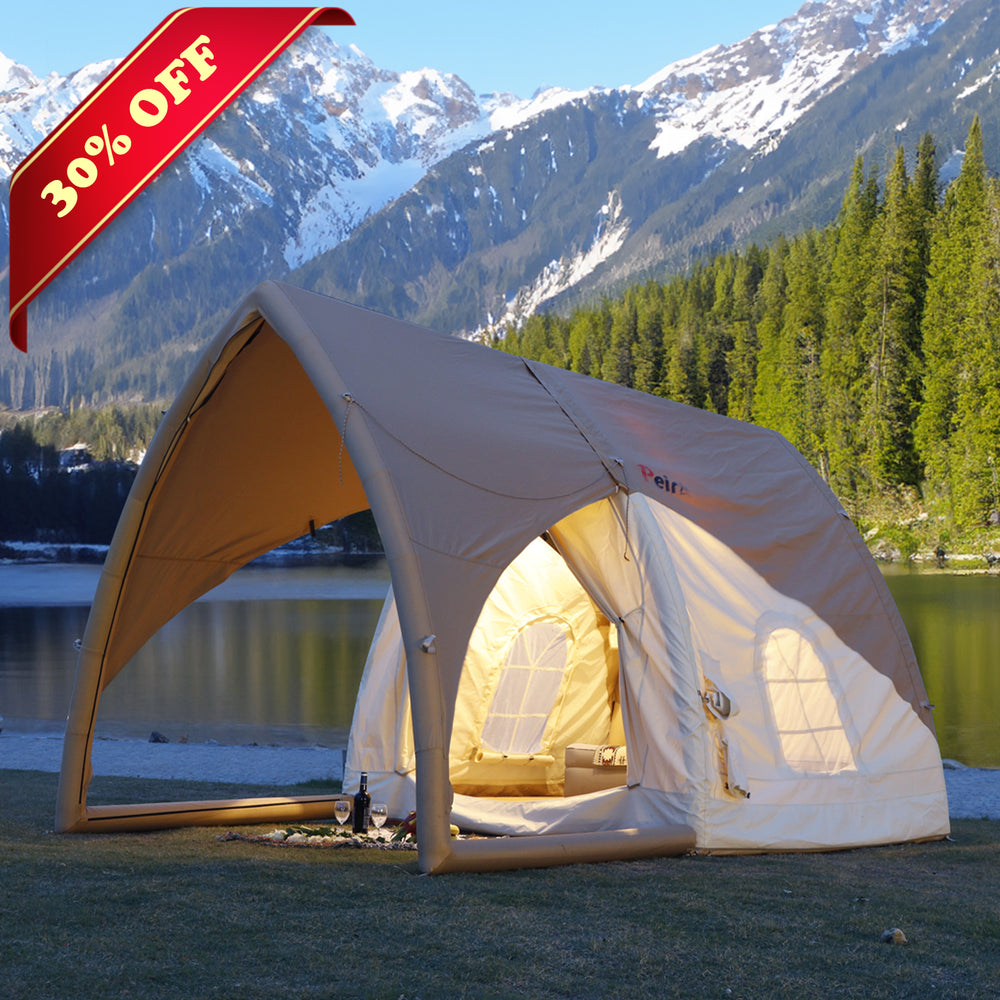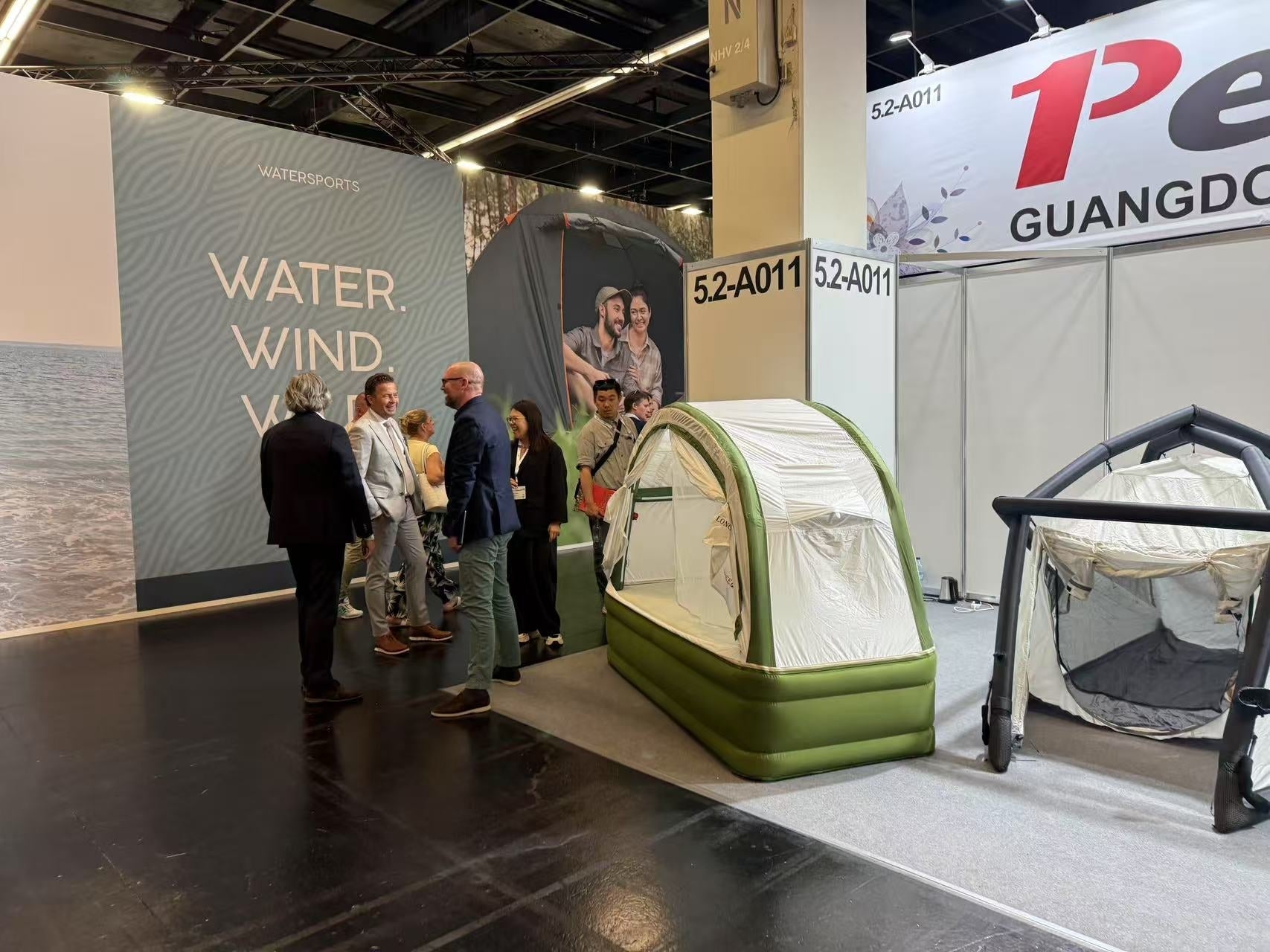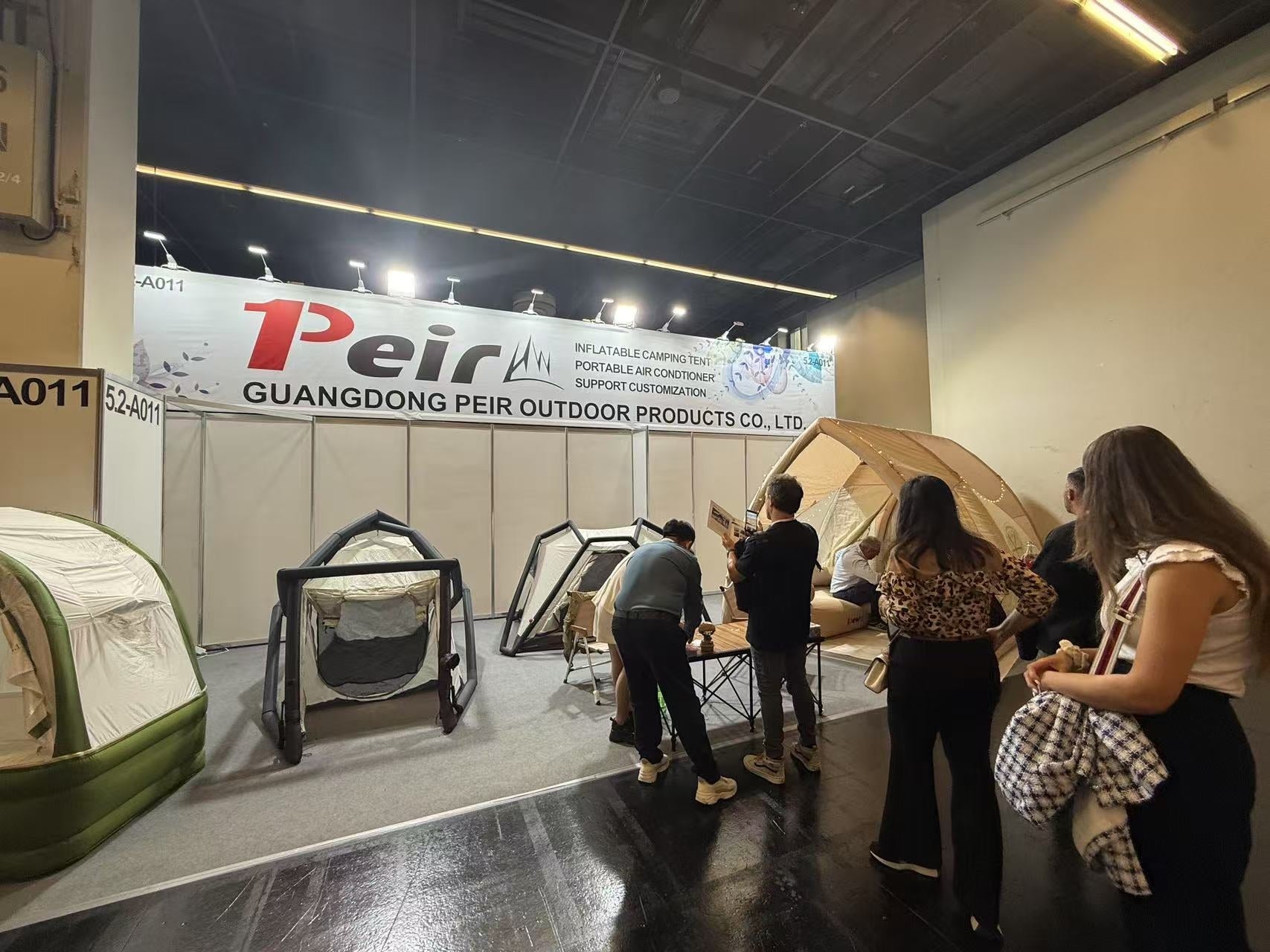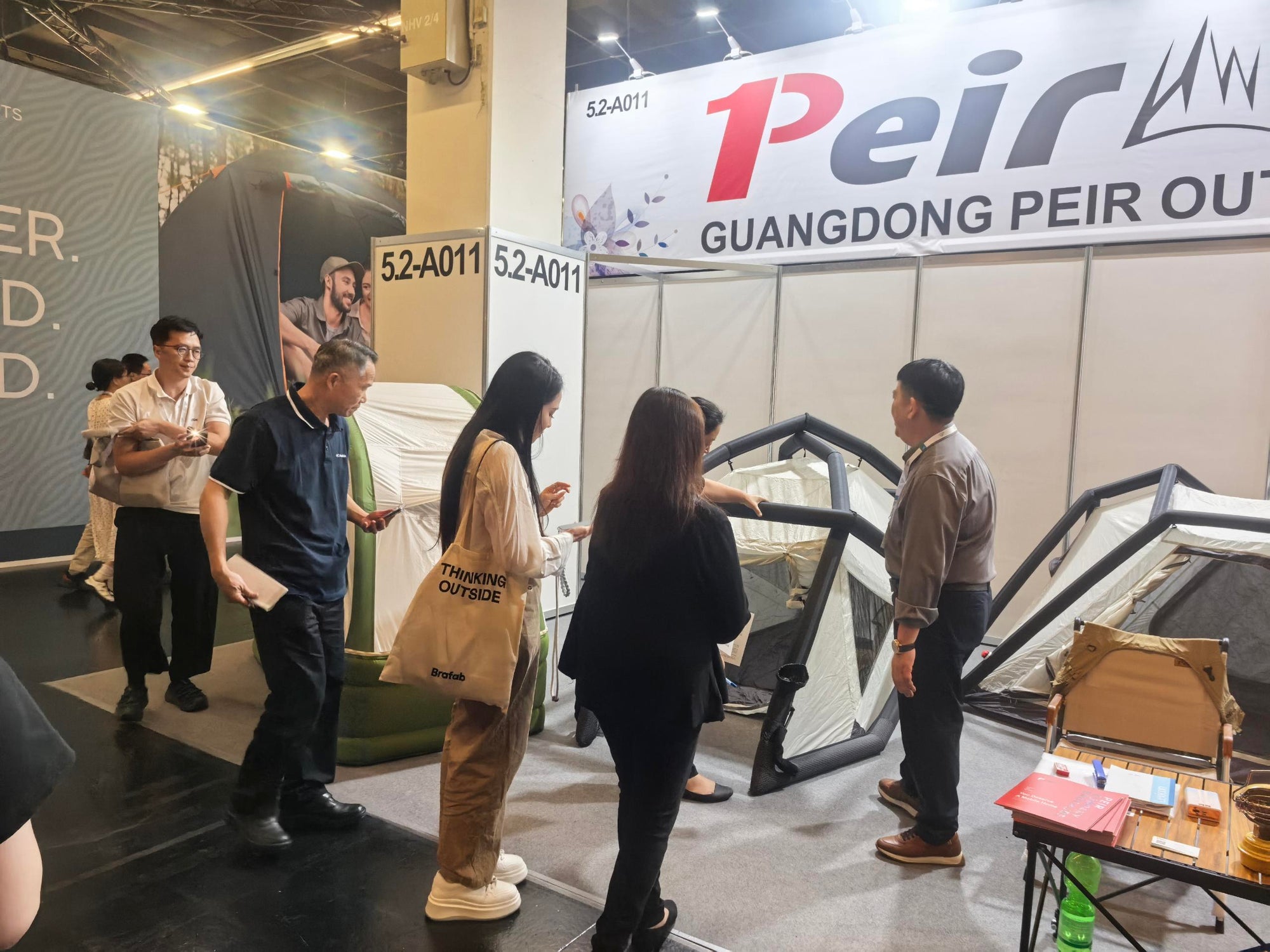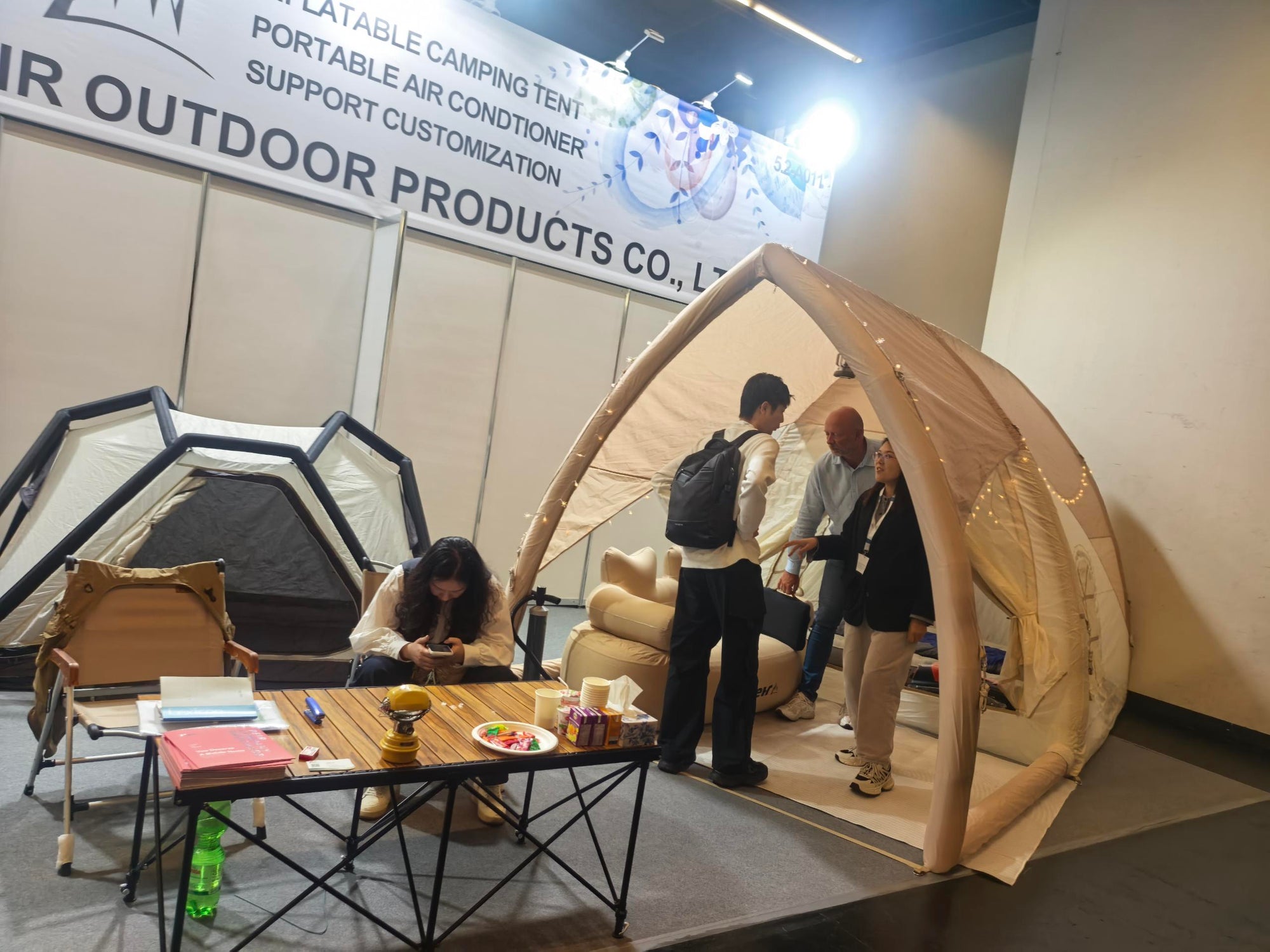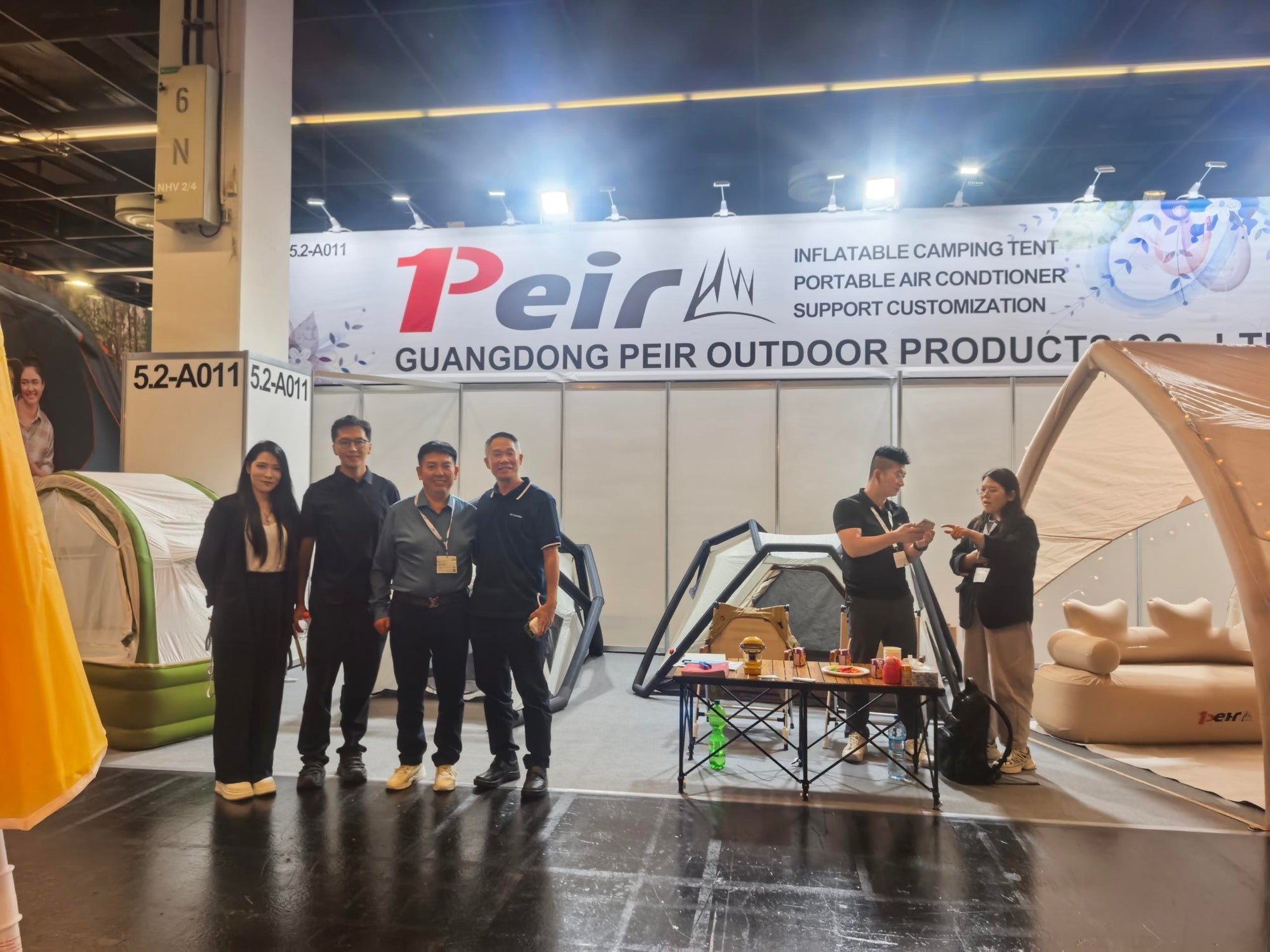Inflatable Tents vs. Traditional Tents: A Comprehensive Comparison
My first camping trip was in the mid-1970s with my family in upstate New York. I distinctly remember the chill of the air in the Inflatable tent at night, the smell of the trees, and the feeling of the dirt between my fingers as my brother and I played in the forest around our camp. It was so much fun – and I remember it vividly 40-something years later!
That trip – and many others after it – instilled in me a love of the outdoors. That passion has stuck with me throughout my life, and is something I’m passing on to my son now. It’s also a passion that led me to found 4WDTalk a few years back. If you’re going to work, it might as well be in a field you love!
Subscribe to our weekly newsletter
Since founding 4WDTalk, I’ve tested a lot of tents – traditional ground tents, rooftop tents, hard-sided tents, hot tents – you name it. But in the last couple of years, I’ve focused more on field testing inflatable tents.
Inflatable tents, like my Sonmez London Maxia 480, are absolutely huge.
These tents have become wildly popular in recent years, and for good reason. As I’ll explain below, inflatable tents have a host of features that make them easy to use and incredibly functional. But, as with any outdoor gear, it’s not all sunshine and roses. Thus, the debate about inflatable tents – do the advantages outweigh the disadvantages enough to make them a worthy option?
Here are a few things I’ve learned – both good and bad – that will help you determine if buying an inflatable tent is worth your hard-earned cash.
Advantages of Inflatable Tents
Inflatable tents, like my Sonmez London 360 Discover, are easy to set up.
At the top of my list of advantages of these tents is the ease of setup. Unlike traditional tents with poles that somehow always manage to get caught on something, inflatable tents merely need air to take their shape.
It’s a three-step process, really:
Lay out a tarp, ground cloth, or tent footprint.
Lay out the tent.
Start pumping!
Now, I highly recommend using an electric pump and a power station to do most of the inflation. I use a cheap pump I got on Amazon and power it with a Goal Zero 1500x. Just about any combination of pump and power source will work here, though.
I have found that the pump struggles toward the end due to the high pressure in the tent. So, I use a manual pump to finish inflating the tent and get the correct PSI.
Invest in a good pump and power source to take care of inflating your tent.
The time required to inflate one of these tents varies based on size, of course, but it’s generally a matter of a few minutes. While the electric pump does its thing, I can concentrate on getting other gear loaded and get two things done at once.
Related to this is the ease of deflating the tent; it’s a simple matter of opening valves to start the process. Again, I can tend to other tasks while the tent deflates, then help it out toward the end by carefully compressing the chambers to force the remaining air out.
I’ve found there to be many other benefits of inflatable tents, too…
Inflatable Tents are Comfortable
My son showing off the three rooms inside one of our inflatable tents.
I’ve done a lot of camping in tents recently, and I have to say they provide a more comfortable space for hanging out and sleeping than any traditional tent or rooftop tent I’ve tested.
A big part of this is the sheer amount of space – some of these tents are 100 sq. ft. or more, so you have plenty of room to spread out. Heck, one of my inflatable tents, the Sonmez London Maxia 480, has three rooms!
When you’re like me and you often have to work while you’re camping or overlanding, you have a lot of gear. I have the typical camping stuff, like a cot, sleeping pad, and sleeping bag. But I also have a portable table, my laptop, Starlink, a power station…you get the point. I need my tent to be my sleeping quarters, my hangout area, and my office, so the size of an inflatable tent is a huge benefit.
Inflatable tents, like my RBM Outdoors Panda, offer loads of headroom.
The fact that I can stand up straight in an inflatable tent is nice, too. Now that I’m in my 50s, crawling around in a pup tent or rooftop tent isn’t at the top of my list of things I want to do. But in an inflatable tent, I can roll out of bed, stand up, and stretch with ease.
I’ll add another comfort feature to the list – tons of windows. Again, while every tent is different, most of the ones I’ve tested have had huge windows that make the tent light, bright, and airy. In fact, many inflatable tents have clear panels on the roof, allowing even more natural light inside. Better still, these panels afford you a nice view of the night sky so you can sleep under the stars with the advantage of being protected from the elements.
Inflatable Tents are Stable
The guy lines on my RBM Outdoors Panda inflatable tent provide added stability.
If you’ve never camped with an inflatable tent, I don’t blame you for questioning how they hold up in strong winds. Visions of those dancing air tubes at used car lots are probably running through your head right now!
However, once an inflatable tent is full of air, they are rock-solid. Now, tying the tent down with guy lines and stakes is an absolute must, but once that’s done, you’ll be shocked at just how stable these tents can be.
In fact, I’ve camped in 50+ mph winds in an inflatable tent and was blown away (not literally!) by just how solid the tent was. I’ve also been amazed at how quiet these tents are in windy conditions. I’ve had rooftop tents in the past that flapped loudly in the wind and kept me up all night. Yet, in my experience, wind noise isn’t a problem in these tents.
Inflatable Tents are Durable
Inflatable tents are quite durable – especially high-end models.
Another common misconception about inflatable tents is that they’re delicate. I’ll admit that I wondered about their durability, too, before taking my first camping trip with one. But those worries were quickly dispelled once I began testing these tents. In my experience, the tents I’ve tested have been the height of durability with high-quality materials that resist punctures.
And even if an inflatable tent suffers a puncture, most manufacturers provide patch kits that are easy to install and extremely strong.
Sure, you need to take care when selecting where you set up the tent – amidst a patch of cacti is probably not the best idea. But if you have a footprint under the tent and avoid areas with sharp objects, your inflatable tent should last you a good, long time.
Inflatable Tents are Versatile
The size of inflatable tents means they provide tons of versatility.
As I discussed earlier, some tents are absolutely huge – like the size of a studio apartment in New York City! With that kind of size comes excellent versatility.
For example, when I’m on a trip with my family and other families, we’ll use one of my inflatable tents for our sleeping quarters and my office and another one of my inflatable tents as a living area and hangout space. On other occasions, we’ll use one of the inflatable tents for a dining area, especially if the weather isn’t all that great.
The point is that these tents pull double, triple, and quadruple duty if you need them to. Think of them like individual rooms in your house that you can use for virtually any purpose. Heck, you can even use one of these tents as a restroom enclosure to have privacy when nature calls or you need to take a quick campsite bath.
Disadvantages of Inflatable Tents
Inflatable tents can be very heavy and hard to maneuver.
As I said earlier, inflatable tents aren’t without their downsides…
For me, the biggest drawback of inflatable tents is their weight. One of my tents – the Sonmez London Maxia 480 I mentioned earlier – tips the scales at nearly 170 pounds (though, ironically, it’s my favorite tent!). It’s a good thing I work out and have buddies with me on my trips, otherwise, it would be downright impossible for me to get this sucker out of the truck and into position.
The workaround is what I just mentioned – make sure you have some able-bodied friends or family members on the trip with you so they can help you get your tent set up. Maybe bring a back brace, too!
My second biggest complaint about these tents is that you’re dependent on a pump. If your electric pump fails, or, if God forbid, you forget it, you’re in for a very long afternoon.
But you also have to have room to bring an electric pump, something to power it, and a manual pump as a backup. If you’ve done any amount of camping or overlanding, you know that space is at a premium. Having an inflatable tent means having to bring even more stuff with you to take up that precious space.
Be prepared for some sticker shock when shopping for a quality inflatable tent.
A third disadvantage of inflatable tents is their cost. By and large, the inflatable tents I’ve tested have been much more expensive than traditional pole-based tents. Granted, I’ve tested mostly high-end inflatable tents that are very large, so a high cost is to be expected. But with prices that can exceed $6,500 in some cases, you could be in for a very expensive investment.
Here are a few other concerns about inflatable tents, though from my point of view, these are very minor worries:
Puncture risk – As I mentioned earlier, taking care when setting up your tent and having a tent footprint goes a long way in preventing punctures. Nevertheless, the processes of setting up, taking down, and transporting these tents opens them up to accidental damage no matter how careful you are.
Repairs can be time-consuming – Patching a leak in an inflatable tent is actually really easy; finding the leak can be the hard part. Large punctures, holes, or tears can also be troublesome to address, especially if you’re in the field and don’t have a large enough patch to cover the damage.
You have to supply your own pump – Most inflatable tents don’t come with a pump, for some reason. You’d think that would be part of the deal, especially if it’s a high-end tent with a big price tag. On top of that, having a pump means having one more thing that requires maintenance (and that might malfunction).
The Real Story of Inflatable Tents
From the beach to the mountains, I’ve found inflatable tents to be well worth it!
Having outlined the advantages and disadvantages of inflatable tents, it’s safe to say that, for me, anyway, the benefits far outweigh the detriments. Sure, you have to take care with an inflatable tent, maintain it, and use it properly to get the best performance, but that’s true of any camping gear.
And while they are heavy, inflatable tents at least pack down into a very small form factor (for their inflated size, anyway), so you can easily add one of these tents to your overlanding or camping setup without sacrificing a huge amount of space in your vehicle or trailer.
Now, are all inflatable tents made equal? Absolutely not!
I’ve tested these tents of all price ranges and have found one thing to be true – cheap tents have smaller air changers, which tend to buckle more easily. They’re also more susceptible to instability in windy conditions.
So, if an inflatable tent sounds like a good plan for your outdoor adventures, my advice is this – invest in the best tent you can afford. As they say, you get what you pay for, so while a cheap tent might be enticing, in the end, a high-quality, well-made inflatable tent will be more durable, more stable, and give you better performance over a longer period of time.
Breathe cleaner air with the PuroAir 240 HEPA Air Purifier! Perfect for large rooms up to 1,000 sq ft, it removes 99.9% of pollutants, smoke, dust & pollen. Ultra-quiet & powerful for bedrooms. For more details click here.
FREQUENTLY ASKED QUESTIONS
How do you repair an inflatable tent if it gets punctured or damaged?
Inflatable tents are a fantastic option for campers seeking convenience and portability. However, like any gear relying on air, they are susceptible to punctures, tears, and wear. Here’s a step-by-step guide to get your tent back in shape if it gets damaged:
1. Identify the Damage
Visual Inspection: Start by visually inspecting your tent. Inflate the beams and look for any visible holes or tears.
Sound Test: Listen for hissing noises, which can indicate escaping air.
Soapy Water Method: Mix soap and water and apply it to the suspected area. Bubbles will form where air escapes.
2. Prepare for Repair
Dry the Area: Ensure that the affected area is completely dry before starting the repair.
Clean the Surface: Use a cloth to clean the surface around the damage to ensure the patch adheres well.
3. Repair Kit Essentials:
Most reputable inflatable tents come with a repair kit. If yours is missing one, here’s what you’ll need:
Adhesive Glue: Designed for inflatable materials.
Patches: Typically vinyl or the same material as your tent.
Tape: To reinforce patches if necessary.
4. Patch the Damage
Apply Glue: Spread a thin layer of adhesive around the hole.
Attach Patch: Place the patch firmly over the hole, ensuring no air bubbles are trapped underneath.
Press Firmly: Apply pressure to the patch for several minutes to ensure a strong bond.
5. Reinforce and Test
Use Tape: For added security, apply tape around the edges of the patch.
Inflate and Test: Once the glue has dried, inflate the tent and check if the repair holds. Repeat the soapy water test to ensure no bubbles form.
6. Post-Trip Repairs
Once back home, consider redoing the repair with professional-grade materials for a longer-lasting fix. This will ensure your tent is ready for your next adventure.
Properly maintaining and repairing your inflatable tent can extend its lifespan, ensuring that it remains a reliable part of your camping gear season after season.
How do environmental conditions like temperature affect inflatable tents?
How Temperature Affects Inflatable Tents
Inflatable tents are innovative solutions for outdoor enthusiasts, but they can be sensitive to changes in environmental conditions, especially temperature. Here’s a closer look at how temperature plays a crucial role:
Temperature Drops
When the temperature decreases, the air inside the inflatable frame contracts. This can lead to deflation, which might leave your tent sagging or even collapse if not properly maintained. To prevent this, ensure regular monitoring of the tent’s firmness, especially during cold nights or sudden weather shifts.
Temperature Increases
Rising temperatures can be even more challenging. Warm air expands, which might lead to overinflation. This can cause excessive pressure on the tent’s frame, potentially resulting in rupture or irreversible damage. The key here is vigilance—monitor weather forecasts and release some air if a heatwave or warm spell is predicted.
Proactive Tips
Weather Monitoring: Regularly check weather updates when planning your trip and while camping. This helps in anticipating temperature fluctuations.
Pressure Adjustments: Carry a pressure gauge to precisely measure and adjust the tent’s inflation level as needed.
Location Selection: Pitch your tent in a shaded or well-ventilated area to minimize temperature extremes.
Understanding these temperature effects and taking proactive measures will ensure that your inflatable tent remains a reliable shelter throughout your outdoor adventures.
What materials are commonly used in the construction of inflatable tents?
Common Materials Used in Inflatable Tent Construction
Inflatable tents are designed with durability and functionality in mind. A key material used in their construction is polyurethane, which is both robust and resistant to water. This makes it an ideal choice for tent frames.
However, polyurethane frames require meticulous care and should be properly stored when not in use. Despite this need for careful handling, they are generally easy to repair if an issue arises.
Considerations for Polyurethane
Puncture resistance: While polyurethane is strong, punctures, tears, and general wear can occur.
Repairability: Tents frequently come with a repair kit, often including glue, patches, and tape, enabling quick fixes onsite to ensure usability for the duration of your camping trip.
Thus, while inflatable tents offer convenience and portability, understanding the materials used in their construction provides insight into their maintenance and longevity.
How do you choose the right inflatable tent for your needs?
Now, are all inflatable tents made equal? Absolutely not!
I’ve tested these tents of all price ranges and have found one thing to be true – cheap tents have smaller air changers, which tend to buckle more easily. They’re also more susceptible to instability in windy conditions.
So, if an inflatable tent sounds like a good plan for your outdoor adventures, my advice is this – invest in the best tent you can afford. As they say, you get what you pay for, so while a cheap tent might be enticing, in the end, a high-quality, well-made inflatable tent will be more durable, more stable, and give you better performance over a longer period of time.
Key Features to Consider:
Waterproofing: Ensure your tent has a well-insulated canopy with glued seams and a hydrostatic rainfly. This will keep you dry during unexpected downpours and enhance your tent’s durability.
Size and Capacity: Think about your group size and add one extra person to your calculations for comfort. For instance, a family of four should consider a 5-person tent to ensure ample space for both people and gear.
Inflatable Beams: Check that the self-inflatable frame is constructed from high-quality materials. Consult the manufacturer’s guidelines for proper handling to avoid wear and tear, and ensure a repair kit is included.
Ventilation: A well-ventilated tent is crucial, especially in summer. Look for features like large windows, vent holes with mosquito nets, and mesh ceilings to prevent moisture buildup and keep the interior fresh.
Headroom and Accessibility: Consider tents with sufficient headroom so you can move comfortably inside. Dual entrances can also enhance convenience, allowing easy access without disturbing others.
Winter Considerations: If you plan to camp in colder months, think about compatibility with a wood stove. Safety is key, so ensure the stove area is equipped with heat-resistant mats and follow all safety instructions.
By focusing on these elements, you’ll not only ensure comfort and safety during your camping trips but also make a wise investment in a tent that can withstand the elements and serve you well for years to come.
What is an inflatable tent and how does it differ from traditional tents?
Inflatable tents, like my Sonmez London 360 Discover, are easy to set up and offer a modern twist on traditional camping shelters.
What Exactly Is an Inflatable Tent?
An inflatable tent features a canopy supported by an air-filled frame, replacing the metal or fiberglass poles used in traditional tents. This innovative design allows the tent to be erected with a pump, making setup straightforward and efficient.
How Does It Differ from Traditional Tents?
Unlike conventional tents, which often require wrestling with poles that somehow always manage to get caught on something, inflatable tents only need air to take their shape. Here’s a quick look at how simple the setup can be:
Lay out a tarp, ground cloth, or tent footprint.
Lay out the tent.
Start pumping!
Now, I highly recommend using an electric pump and a power station to do most of the inflation. I use a cheap pump I got on Amazon and power it with a Goal Zero 1500x. Just about any combination of pump and power source will work here, though.
I have found that the pump struggles toward the end due to the high pressure in the tent. So, I use a manual pump to finish inflating the tent and get the correct PSI. Invest in a good pump and power source to take care of inflating your tent.
The time required to inflate one of these tents varies based on size, of course, but it’s generally a matter of a few minutes. While the electric pump does its thing, I can concentrate on getting other gear loaded and get two things done at once.
Related to this is the ease of deflating the tent; it’s a simple matter of opening valves to start the process. Again, I can tend to other tasks while the tent deflates, then help it out toward the end by carefully compressing the chambers to force the remaining air out.
Inflatable tents also offer greater stability when pegged to the ground, providing a secure and reliable shelter. Their design not only simplifies the camping experience but also enhances it by allowing you to focus on the adventure ahead.
How does solo camping in an inflatable tent provide comfort and relaxation?
How Solo Camping in an Inflatable Tent Offers Unmatched Comfort and Relaxation
Solo camping in an inflatable tent transforms the wilderness into a serene retreat, blending nature’s tranquility with modern conveniences. Here’s how:
Effortless Setup
Inflatable tents, from brands like Vango and Decathlon, simplify the camping experience. Their intuitive design allows for quick setup—just a few minutes, and your cozy haven is ready. This means more time relaxing and enjoying your surroundings, with less fuss and frustration.
Home-Like Comforts
These tents often feature spacious interiors, resembling the comfort of home. High ceilings and ample space provide a sense of freedom, while built-in airbeds or slots for inflatable mattresses ensure a restful night’s sleep. Your solo adventure becomes a personal sanctuary, offering respite from the demands of daily life.
Nature at Your Doorstep
Choosing a campsite near a gentle river or nestled among tall trees enhances relaxation. The soothing sounds of flowing water and birdsong create a peaceful backdrop, perfect for unwinding. Inflatable tents often have large windows or transparent panels, allowing you to soak in the natural beauty from the comfort of your sleeping bag.
Weather-Resistant Design
Modern inflatable tents are designed to withstand various weather conditions. Whether you’re camped out during a light rain or under a starry sky, these tents provide shelter and security. Their robust materials protect from the elements, letting you unwind without worry.
A Break from Routine
Setting out on a solo camping trip offers a chance to disconnect from technology and embrace solitude. It’s an opportunity to meditate, read, or simply enjoy your own company, rejuvenating your mind and body.
By combining the ease of setup, home-like comforts, and immersion in nature, inflatable tents create a solo camping experience that’s both relaxing and revitalizing.
What are the best practices for maintaining and repairing inflatable tents?
Certainly! Here’s the revised passage incorporating the thoroughness of Their article into Your article:
Sure, you have to take care with an inflatable tent, maintain it, and use it properly to get the best performance, but that’s true of any camping gear.
Inflatable tents are crafted from sturdy, resilient materials like water-resistant polyurethane. These materials not only provide durability but also require special care to ensure longevity. Proper storage is crucial, as it helps in preserving the tent’s integrity against environmental factors.
While these tents are generally easy to repair, punctures, tears, and normal wear are issues to keep an eye on. Punctures and tears are common challenges, often resulting from sharp objects or rough handling. Wear and tear, though inevitable over time, can be managed with regular checks and maintenance.
Luckily, many reputable brands equip their tents with repair kits, including essentials like glue, patches, and tapes. This means you can handle repairs on the spot during your adventure, keeping your tent functional throughout the trip. The inclusion of a repair kit ensures that minor damages can be quickly addressed, preventing further deterioration.
Once you return home, it’s wise to give your tent a thorough inspection and perform any necessary repairs to maintain its integrity for future outings. Conduct a detailed check for any lingering issues that might have been overlooked in the field, ensuring that your tent remains in top condition for your next camping experience.
By following these best practices, you can extend the life of your inflatable tent and enjoy many more adventures under the stars.
Why are inflatable tents becoming popular among campers?
Inflatable tents have become wildly popular in recent years, and for good reason. As I’ll explain below, inflatable tents have a host of features that make them easy to use and incredibly functional.
Quick and Easy Setup
One of the standout benefits is the ease of setup. Pitching an inflatable tent takes less time and effort compared to traditional tents. All you need is a manual or electric pump. Simply connect the hose to the valve and pump until the canopy stands straight up. This hassle-free process means more time enjoying the great outdoors and less time wrestling with tent poles.
Lightweight and Portable
Another reason for their growing popularity is their portability. Unlike tents with heavy metal or fiberglass frames, inflatable tents are designed to be lightweight. This makes them much easier to carry around, whether you’re hiking to a remote campsite or setting up in your backyard.
Practical and Convenient
The combination of easy setup and lightweight design provides practical advantages that make inflatable tents a top choice for both seasoned campers and beginners alike. These tents offer comfort and convenience without compromising on durability or style. Whether you’re looking to cut down on setup time or lighten your load, these tents offer an ideal solution for modern camping adventures.
In addition to these benefits, inflatable tents eliminate the need for heavy, cumbersome poles, providing a seamless experience that caters to the needs of today’s campers. With these practical features, it’s no wonder campers are increasingly turning to inflatable tents for their outdoor escapades.
What equipment and gear are recommended for an inflatable tent camping trip?
Invest in a good pump and power source to take care of inflating your tent. The time required to inflate one of these tents varies based on size, of course, but it’s generally a matter of a few minutes. While the electric pump does its thing, I can concentrate on getting other gear loaded and get two things done at once.
Essential Gear for Your Inflatable Tent Camping Trip
To make your camping experience seamless, consider adding these items to your checklist:
Inflatable Tent: Choose a tent that suits your needs, whether it’s for solo adventures or a cozy trip for two. Look for features like a stove jack if you’re planning on cooking inside.
Titanium Camping Cookware Set: Lightweight and durable, titanium cookware is ideal for preparing meals without adding unnecessary weight to your backpack.
Inflatable Sleeping Air Pad with Pillow: Ensure a good night’s sleep with a comfortable air pad. Look for one with an integrated pillow for added convenience.
Related to this is the ease of deflating the tent; it’s a simple matter of opening valves to start the process. Again, I can tend to other tasks while the tent deflates, then help it out toward the end by carefully compressing the chambers to force the remaining air out.
By preparing with the right gear, you can make your inflatable tent camping trip both efficient and enjoyable.
What additional accessories can be used to improve the camping experience in an inflatable tent?
Now, I highly recommend using an electric pump and a power station to do most of the inflation. I use a cheap pump I got on Amazon and power it with a Goal Zero 1500x. Just about any combination of pump and power source will work here, though.
I’ve found that the pump struggles toward the end due to the high pressure in the tent. So, I use a manual pump to finish inflating the tent and get the correct PSI. Invest in a good pump and power source to take care of inflating your tent.
Enhance Your Camping Experience
Beyond setting up your inflatable tent with ease, consider adding these accessories to make your outdoor adventure even more enjoyable:
Inflatable Sofa: Perfect for lounging under the stars, an inflatable sofa provides comfort and portability. Look for options that are easy to inflate and deflate for convenience.
Adjustable Bamboo Table: A versatile table can serve as your dining area or a place to organize your gear. Adjustable height options are great for accommodating different needs, whether you’re preparing meals or playing games.
Padded Butterfly Chair: For those who love to relax by the campfire, a padded butterfly chair offers both style and comfort. Lightweight and foldable, it’s easy to pack and set up wherever you desire.
Each of these accessories can significantly enhance your camping experience, offering comfort and practicality. Combining these with a well-inflated tent ensures that your time in the great outdoors is as enjoyable and stress-free as possible.
What are some specialized types of inflatable tents available on the market?
Specialized Inflatable Tents on the Market
When it comes to inflatable tents, there’s a diverse range catering to various needs and preferences, providing options for unique camping experiences. Below, we outline some popular types and their features, along with price ranges to help you make an informed decision.
1. Transparent Cabin Tents
For those who love stargazing or simply want a clear view of their surroundings, transparent canopy tents are a great choice. These see-through designs allow campers to enjoy nature from the comfort of their tent, making them perfect for weekend getaways. Prices typically range from $1,000 to $2,500, depending on size and additional features like UV protection and durability.
2. Inflatable Indoor Tents for Kids
Designed for indoor use, these inflatable tents provide a fun and safe space for children to play or even camp inside their own home. They are often colorful and easy to set up, encouraging imaginative play. You can find these tents at more affordable prices, usually between $50 and $200.
3. Floating Inflatable Tents
A true innovation, floating tents transform a camping adventure into a water-specific experience. Essentially, these are inflatable rafts with an attached cabin designed for floating on lakes or rivers. They must be durable, waterproof, and include features like high-quality ropes and anchors to ensure safety and stability on the water. While they offer a thrilling experience, they are a less common option and can be pricey, ranging from $1,500 to $3,000.
4. Family-Sized Inflatable Tents
These tents cater to larger groups, often accommodating up to 10 people. They typically feature multiple rooms and quick setup times, making them ideal for family outings or group trips. Prices for these tents can vary, generally starting around $1,500 and reaching up to $3,000, depending on capacity and additional amenities like panoramic roof windows or built-in ventilation systems.
5. Compact Inflatable Tents for Solo Travelers
Perfect for solo adventurers, these tents are designed for quick setup and portability. Lightweight and compact, they are easy to carry and ideal for those who prefer minimalistic camping. These can cost between $200 and $1,000, with factors such as material quality and ease of inflation affecting the price.
By understanding the variety of inflatable tents available, you can select the one that best meets your needs, whether you’re planning a family vacation, an indoor play session, or a solo adventure.
What size mattress fits in the bedroom space of the inflatable tent?
To maximize comfort in your inflatable tent’s bedroom space, consider opting for a queen-sized mattress. Specifically, an 18-inch high inflatable mattress can fit well, providing both ample room for sleeping and ease of setup within limited confines. This size efficiently utilizes the area, ensuring you have enough room to move around without feeling cramped.
What is the wind rating for inflatable tents, and how can they be secured?
Inflatable tents are quite durable – especially high-end models.
Another common misconception about inflatable tents is that they’re delicate. I’ll admit that I wondered about their durability, too, before taking my first camping trip with one. But those worries were quickly dispelled once I began testing these tents. In my experience, the tents I’ve tested have been the height of durability with high-quality materials that resist punctures.
And even if an inflatable tent suffers a puncture, most manufacturers provide patch kits that are easy to install and extremely strong.
Securing Your Tent Against the Elements
When it’s windy, it’s crucial to secure your inflatable tent properly to ensure it performs at its best. Most inflatable tents can withstand winds up to 30 miles per hour when anchored correctly. Use pegs and ropes to secure your tent, ensuring stability even in blustery conditions.
Sure, you need to take care when selecting where you set up the tent – amidst a patch of cacti is probably not the best idea. But if you have a footprint under the tent and avoid areas with sharp objects, your inflatable tent should last you a good, long time.
By following these guidelines, you can confidently enjoy your camping trip, knowing that your inflatable tent is both durable and capable of standing up to the wind.
What are the durability and seasonal capabilities of inflatable tents?
Inflatable tents are quite durable – especially high-end models.
Another common misconception about inflatable tents is that they’re delicate. I’ll admit that I wondered about their durability, too, before taking my first camping trip with one. But those worries were quickly dispelled once I began testing these tents. In my experience, the tents I’ve tested have been the height of durability with high-quality materials that resist punctures.
And even if an inflatable tent suffers a puncture, most manufacturers provide patch kits that are easy to install and extremely strong.
Sure, you need to take care when selecting where you set up the tent – amidst a patch of cacti is probably not the best idea. But if you have a footprint under the tent and avoid areas with sharp objects, your inflatable tent should last you a good, long time.
Built for All Seasons
Crafted from durable materials, these inflatable tents offer impressive all-weather resistance. Whether you’re facing rain, wind, or snow, these tents ensure comfort and protection, making them a reliable choice for any camping trip. This resilience is ideal for year-round adventurers who don’t let the weather dictate their plans.
By combining durability with seasonal versatility, inflatable tents provide both peace of mind and adaptability, allowing campers to enjoy the great outdoors anytime, anywhere.
What differences exist between specific air tent models in terms of features?
Now, are all inflatable tents made equal? Absolutely not!
I’ve tested these tents of all price ranges and have found one thing to be true – cheap tents have smaller air changers, which tend to buckle more easily. They’re also more susceptible to instability in windy conditions.
So, if an inflatable tent sounds like a good plan for your outdoor adventures, my advice is this – invest in the best tent you can afford. As they say, you get what you pay for, so while a cheap tent might be enticing, in the end, a high-quality, well-made inflatable tent will be more durable, more stable, and give you better performance over a longer period of time.
Key Features to Consider
When comparing inflatable tents, don’t just look at the price tag. Consider these specific features that can make a big difference:
Dimensions and Space: Larger tents offer more room for comfort and storage. Some models, like certain Koala tents, provide additional space compared to others.
Design Enhancements: Look for tents with built-in roof windows for natural light. Models with room separation can offer privacy and organization.
Window Options: Many quality tents come with plastic windows that can be unzipped for ventilation and views. Check if these are included in both side and roof areas.
Additional Features: High-end models might include a rain fly that doubles as an awning. This provides extra shelter at the entrance and increases versatility.
Stove Jacks: If you plan to camp in colder climates, a stove jack can be a crucial feature, allowing safe use of a stove inside the tent.
Making the Right Choice
In the end, selecting the right inflatable tent comes down to understanding these features and how they meet your needs. Remember, investing in quality means you’ll enjoy more reliable performance, better durability, and ultimately, a more enjoyable camping experience.
What features does an inflatable tent designed for wilderness enthusiasts offer?
Inflatable tents, like my Sonmez London 360 Discover, are easy to set up. At the top of my list of advantages of these tents is the ease of setup. Unlike traditional tents with poles that somehow always manage to get caught on something, inflatable tents merely need air to take their shape.
Key Features of Inflatable Tents for Wilderness Enthusiasts
Rapid Inflation Technology: Set up your basecamp in minutes. Inflatable tents often feature rapid inflation systems, making the setup a breeze and giving you more time to get out and explore. It’s a three-step process, really:
Lay out a tarp, ground cloth, or tent footprint.
Lay out the tent.
Start pumping!
All-Weather Resistance: These tents are constructed from high-quality materials to withstand diverse weather conditions. Look for a properly insulated canopy with glued seams and a hydrostatic rainfly. Be sure vents and electric hookup outlets are designed to prevent rainwater entry.
Spacious & Comfortable: With enhanced ventilation, inflatable tents provide ample space for a comfortable stay. Proper ventilation is crucial — look for canopies with large windows, vent holes with mosquito nets, and mesh ceilings to ensure a livable environment and prevent moisture buildup, which can lead to mold and mildew.
Lightweight & Portable: Easily transportable, these tents are ideal for remote locations and spontaneous adventures. The time required to inflate one of these tents varies based on size, of course, but it’s generally a matter of a few minutes. While the electric pump does its thing, I can concentrate on getting other gear loaded and get two things done at once.
Eco-Friendly Design: Minimize your environmental footprint without compromising on quality and durability. If you plan to camp in colder climates, some inflatable tents are compatible with wood stoves. Ensure you follow safety guidelines, like using heat-resistant mats, to avoid accidents.
Now, I highly recommend using an electric pump and a power station to do most of the inflation. I use a cheap pump I got on Amazon and power it with a Goal Zero 1500x. Just about any combination of pump and power source will work here, though. I have found that the pump struggles toward the end due to the high pressure in the tent. So, I use a manual pump to finish inflating the tent and get the correct PSI. Invest in a good pump and power source to take care of inflating your tent.
Related to this is the ease of deflating the tent; it’s a simple matter of opening valves to start the process. Again, I can tend to other tasks while the tent deflates, then help it out toward the end by carefully compressing the chambers to force the remaining air out.
Just like any camping gear, quality is paramount. Look for products from reputable manufacturers. Check user reviews to understand the tent’s strengths and weaknesses. Most users provide detailed feedback on features, which can help you make an informed decision.
Ultimately, investing in an inflatable tent designed for wilderness enthusiasts means embracing both convenience and robust performance, allowing you to enjoy the great outdoors with confidence.
How can inflatable tents benefit hunters and fishermen?
How Inflatable Tents Benefit Hunters and Fishermen
Hunters and fishermen often seek efficient and flexible shelter solutions, and inflatable tents provide just that. Here’s how they can be a game-changer:
Quick Setup: One of the primary advantages is the rapid setup time. Inflatable tents can be fully assembled in just minutes, allowing outdoor enthusiasts to settle in without hassle.
Portability: These tents are lightweight and easy to transport. Whether you’re hiking deep into the woods or paddling to a secluded fishing spot, inflatable tents won’t weigh you down.
Durability Under Harsh Conditions: Modern inflatable tents, designed by companies like Vango and Heimplanet, are crafted to withstand tough weather. This reliability is crucial for those who need shelter in unpredictable environments.
Space Efficiency: Despite their compact size when packed, many inflatable tents offer ample space once inflated. This is perfect for storing gear, dressing, or even cooking a meal after a long day.
Optimal Comfort: With features like built-in ventilation and customizable spaces, these tents provide a comfortable living area, so you can focus on your adventure without sacrificing comfort.
In essence, inflatable tents offer hunters and fishermen practical, comfortable, and time-saving solutions, making them an indispensable tool for outdoor excursions.
What are some common challenges faced while camping in inflatable tents, as depicted in video adventures?
Common Challenges of Camping in Inflatable Tents
Camping with inflatable tents can transform a standard outdoor experience into a seamless adventure, yet it comes with its own set of unique challenges. Here’s what some video adventures reveal:
1. Setup Time and Process
While inflatable tents are often praised for their quick setup, they can still pose a learning curve for first-timers. Ensuring the tent is fully inflated can sometimes take longer than expected, especially if the pump is manual or inefficient.
2. Durability Concerns
The advantage of an inflatable tent is its lightweight and portable nature. However, this means they’re also more susceptible to punctures. Ensuring the surrounding campsite area is free from sharp objects can be a mindful task. Patching kits are often a necessary part of the gear.
3. Weather Resistance
Although many inflatable tents are touted as all-weather structures, heavy winds and rain can test their limits. The lack of rigid poles might cause concerns in sustaining structural integrity in a storm. Proper staking and using additional guy lines are essential.
4. Space and Capacity
While promotional materials might suggest a tent is spacious enough for a specified number of people, practical fitting can be a squeeze. Personal gear, sleeping arrangements, and comfort can require strategic planning to maximize space.
5. Ventilation
Even with panoramic or roof windows, ensuring adequate ventilation can sometimes be challenging. Balancing this with the need for privacy or protection from the elements often requires experience and experimentation.
6. Accessories and Compatibility
Some inflatable tents come with features like extensions or hubs. Although these add-ons offer flexibility, they can pose confusion over setup compatibility and increase the complexity of the camping experience.
As these videos illustrate, while the problems aren’t insurmountable, awareness and preparation transform potentially frustrating scenarios into enjoyable camping memories.
What are some important criteria for selecting a high-quality inflatable tent?
Their article provides a more thorough response to the question “What are some important criteria for selecting a high-quality inflatable tent?” by offering a detailed and structured overview of various aspects to consider. Here’s how:
Comprehensive Criteria: Their article covers a broader range of features, such as waterproofing, size and capacity, inflatable beams, ventilation, and headroom. It even touches on specific scenarios like winter camping and using a wood stove, which adds depth to the selection criteria.
Detailed Explanations: Each criterion is explained with specific details. For example, waterproofing is not just mentioned but broken down into elements like properly glued seams and hydrostatic rainfly. Similarly, ventilation is described with features like large windows and mesh ceilings.
Practical Advice: The article includes actionable advice, such as the “+1 approach” for tent capacity, ensuring a repair kit is included, and maintaining control over pressure in air beams during heat. This practical guidance helps readers make informed decisions.
Scenario-Based Considerations: It addresses different camping conditions, such as summer ventilation needs and winter heating options, providing a more holistic view of what to consider based on specific camping scenarios.
Safety Precautions: There is a mention of safety precautions, particularly when using a wood stove, which adds an important layer of consideration for potential buyers concerned with safety.
In contrast, Your article, while still informative, focuses more on general advice and fewer specific features. It suggests investing in quality and highlights a few key features but lacks the depth and breadth of criteria provided in Their article.
What are the main features of inflatable camping tents?
Their article provides a detailed breakdown of the main features of inflatable camping tents, making it more thorough in answering the question. Here’s how it does so:
Air Beam Structure: It explains that the tents use air beams instead of traditional metal or fiberglass frames, highlighting a fundamental design difference.
Ease of Setup: The article emphasizes the simplicity of pitching these tents and the necessity of a pump, suggesting a straightforward setup process.
Portability: It mentions the lightweight nature of these tents due to the absence of poles, which enhances portability.
Variety and Capacity: The text covers the availability of different shapes and sizes, including large options that can accommodate groups or families.
Practical Use Cases: It lists various scenarios where these tents excel, such as hiking, car camping, and outdoor events, providing a broad view of their versatility.
Durability and Repairability: The article discusses the robust materials used and the ease of repairing damages with a provided kit, which speaks to the tents’ longevity and resilience.
Geographical Popularity: It also notes the growing popularity of these tents in various regions like the USA, Canada, Europe, Australia, and New Zealand, indicating a wide acceptance.
In contrast, Your article focuses on broader benefits like ease of setup, portability, and practical convenience but does not delve into specific features such as material durability, repair kits, or the specific design elements like air beams. While Your article provides a compelling overview of why these tents are desirable, Their article offers a more comprehensive analysis of their main features.
What is the capacity range of inflatable tents?
Many inflatable tents are designed to accommodate groups or families, typically housing up to 5 or 6 people comfortably.
What accessories are necessary for setting up inflatable tents?
Essential accessories include a pump for inflation, as well as pegs and guy ropes to secure the tent, especially in windy conditions.
How should inflatable tents be stored and cared for?
Inflatable tents require special care and should be stored properly to maintain their condition.
What are common issues with inflatable tents, and how are they addressed?
Common issues include punctures and wear, which can be addressed using a repair kit that typically includes glue, patches, and tapes.
What structural element replaces traditional poles in inflatable tents?
Inflatable tents utilize air beams instead of the conventional metal or fiberglass poles.
What should you do to ensure proper ventilation in an inflatable tent?
Their article provides a more comprehensive answer to the question “What should you do to ensure proper ventilation in an inflatable tent?” by offering specific actions and benefits. Here’s why:
Specific Actions: Their article suggests actively keeping the inside ventilated, which implies taking steps to ensure airflow. It mentions specific features like large windows, vent holes with mosquito nets, and mesh ceilings as means to achieve this.
Consequences and Benefits: It explains the benefits of proper ventilation, such as making the tent more livable and increasing its lifespan by preventing moisture and mildew formation. This provides a clear rationale for why ventilation is crucial.
Direct Advice: While Your article mentions features to look for, it lacks the direct advice about maintaining ventilation and doesn’t explain the consequences of not doing so.
Overall, Their article offers a more detailed answer by combining practical advice with an explanation of the benefits, making it more informative for someone seeking to ensure proper ventilation in an inflatable tent.
What are the consequences of not maintaining proper ventilation?
Failing to ensure adequate airflow can lead to the buildup of moisture and mildew, which can degrade the tent’s condition and diminish its usability over time.
What are the benefits of proper ventilation in a tent?
Effective ventilation improves comfort by keeping the interior livable and extends the tent’s lifespan by reducing the risk of moisture-related damage.
What actions should be taken to ensure proper ventilation?
Maintain airflow by utilizing features such as large windows, vent holes equipped with mosquito nets, and mesh ceilings to enhance ventilation.
How does size and capacity affect the choice of an inflatable tent?
Their article more thoroughly addresses the question of how size and capacity affect the choice of an inflatable tent by providing specific considerations and practical advice directly related to these factors. Here’s how:
Family Size and Extra Capacity: Their article suggests using a “+1 approach,” advising that a family of four should consider a tent designed for five people. This practical tip highlights the importance of having extra space for comfort and gear, directly linking size and capacity to user convenience.
Comfort and Gear Storage: It emphasizes the need for sufficient space not only for the people but also for storing gear, recommending tents with vestibules and pockets. This ties the concept of capacity to practical usage, ensuring the living space remains uncluttered.
Specific Features: The mention of vestibules and pockets provides concrete features to look for, helping readers understand how these elements relate to the overall capacity and functionality of the tent.
In contrast, Your article focuses more on general features of large-capacity tents, such as accommodating many people, multiple rooms, and additional amenities like panoramic windows and ventilation systems. While it provides useful information, it does not directly address how size and capacity affect the choice of a tent with the same level of detail or practical advice as Their article.
How can extra capacity affect comfort inside the tent?
Opting for a tent with more capacity than your group’s size can enhance comfort by offering more space for movement and gear, thus preventing overcrowding.
What features should I look for in a tent to manage space and storage efficiently?
Look for a tent equipped with a vestibule and multiple storage pockets. These features help organize gear and keep the living area free from clutter.
How should I determine the appropriate tent size for my group?
Consider selecting a tent that accommodates one more person than your actual group size. This “+1 approach” ensures additional comfort and provides extra room for belongings.
What types of ventilation features should a tent have?
A tent should ideally have large windows, vent holes with mosquito nets, and mesh ceilings. These features facilitate proper airflow while keeping insects out, enhancing the tent’s comfort and durability.
What happens to air beam pressure when it gets hot?
When temperatures rise, the pressure inside the air beams of a tent can increase significantly. It’s important to monitor and manage this pressure to avoid any potential hazards.
How do you prevent moisture and mildew in a tent?
To prevent moisture and mildew, ensure your tent is well-ventilated. Features like windows, vent holes, and mesh ceilings help maintain airflow and reduce dampness inside.
What are some ideal uses for inflatable camping tents?
They are versatile, making them perfect for activities such as hiking, car camping, and a variety of outdoor events.
How portable are inflatable camping tents?
These tents are designed for convenience, coming with storage bags that fit easily into a car trunk, ensuring they don’t occupy excessive space.
What are the size capacities of inflatable camping tents?
Inflatable camping tents are available in sizes that can accommodate groups or families, typically fitting 5 to 6 people comfortably.






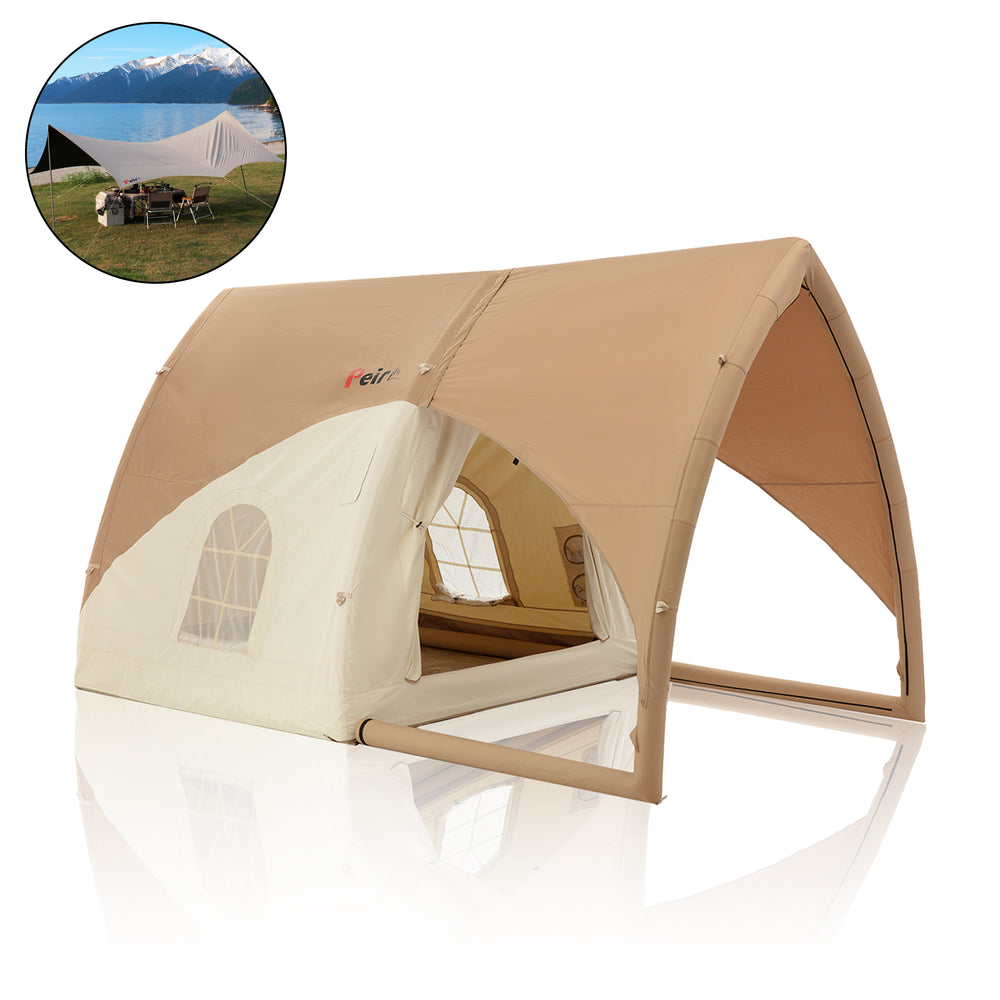
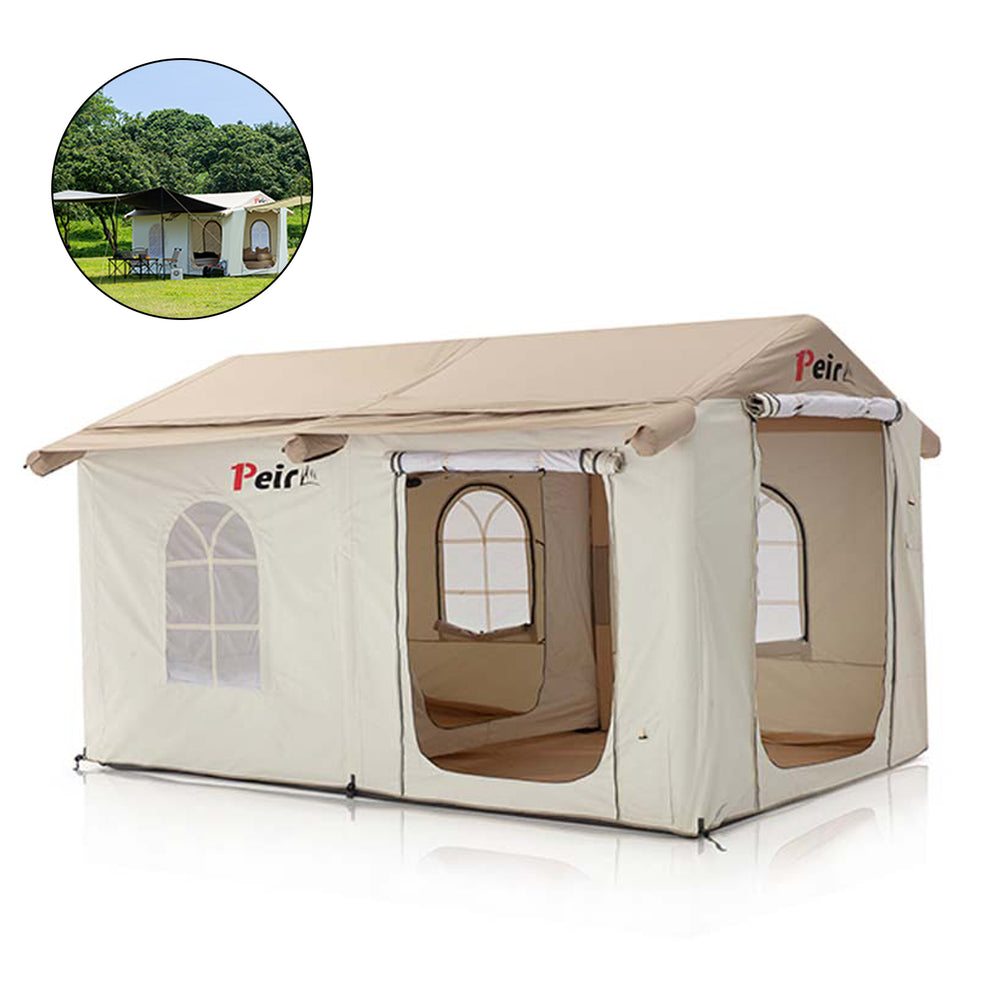
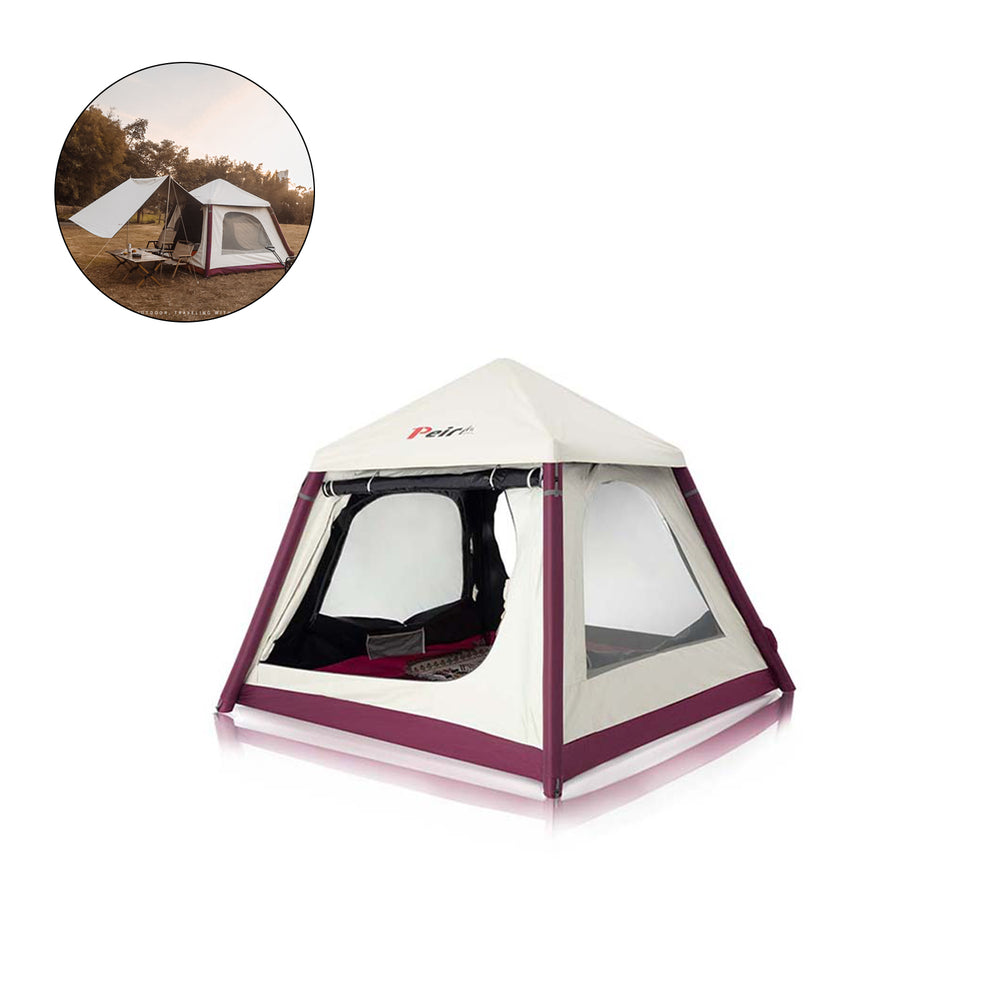
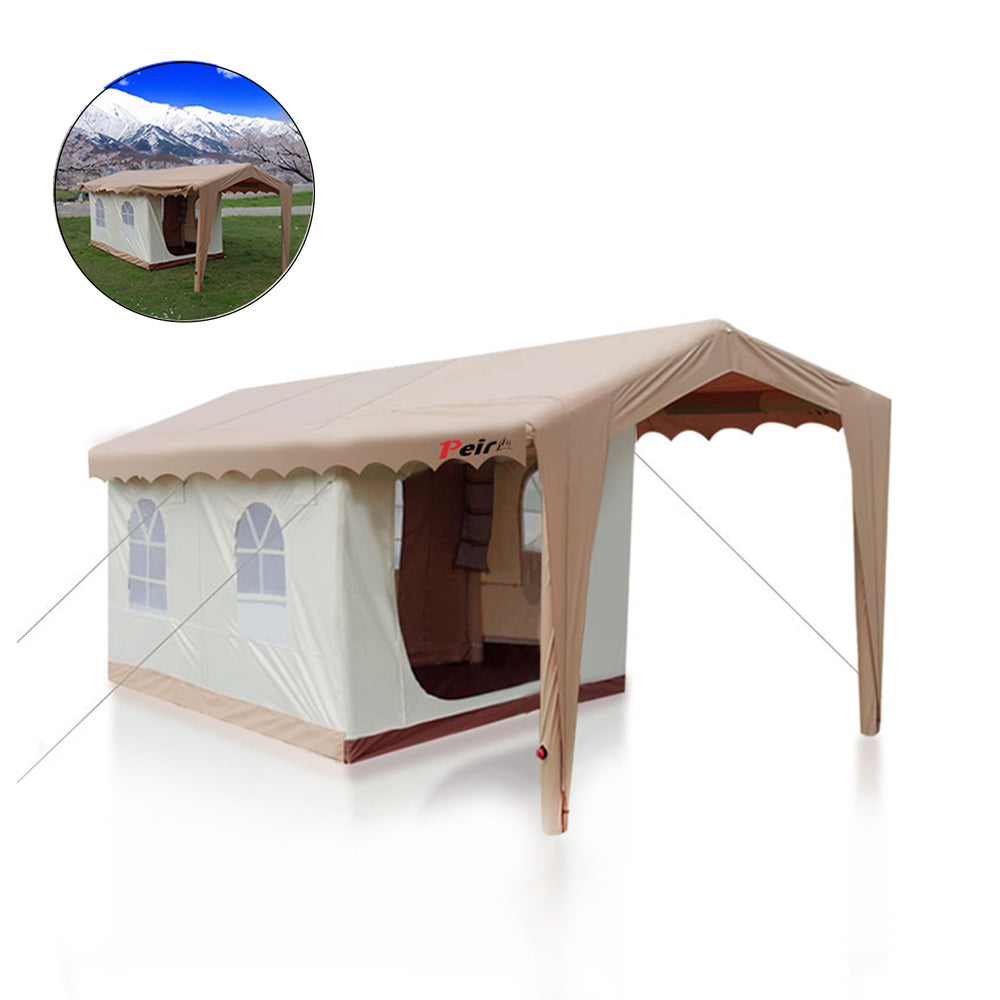
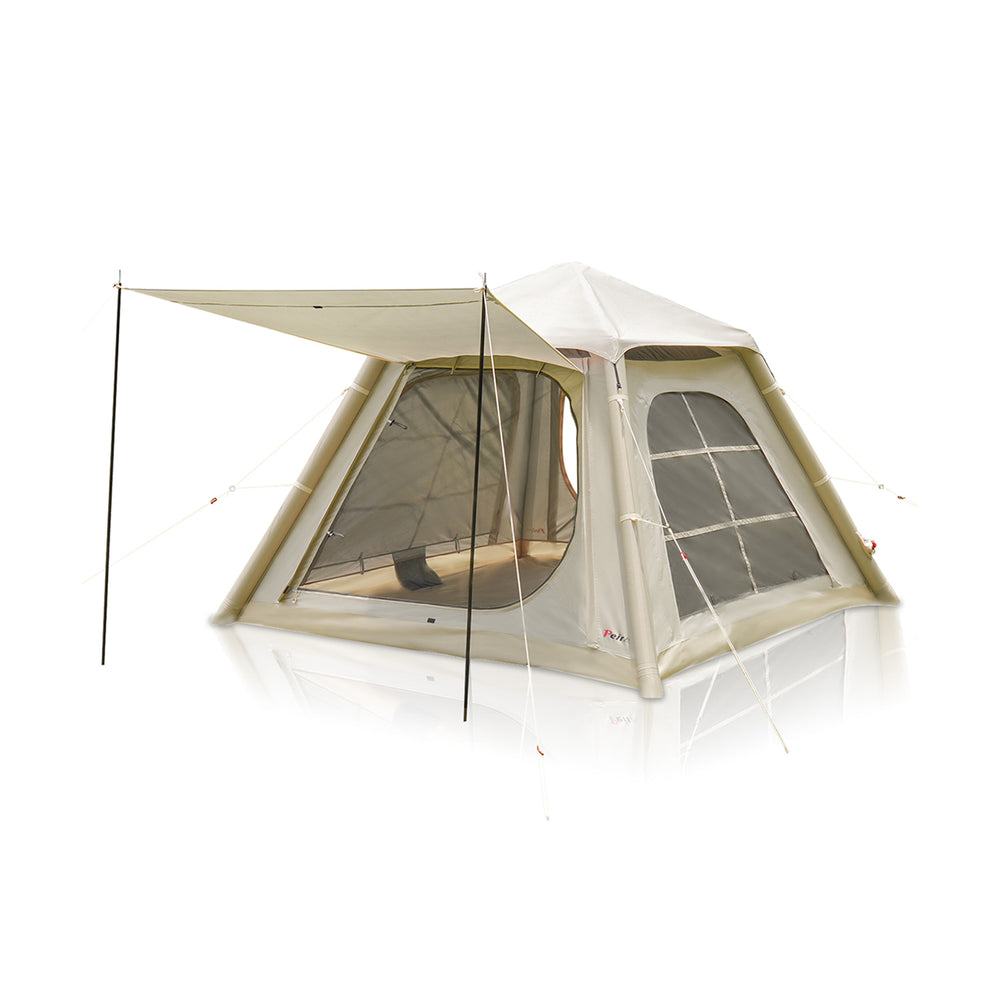
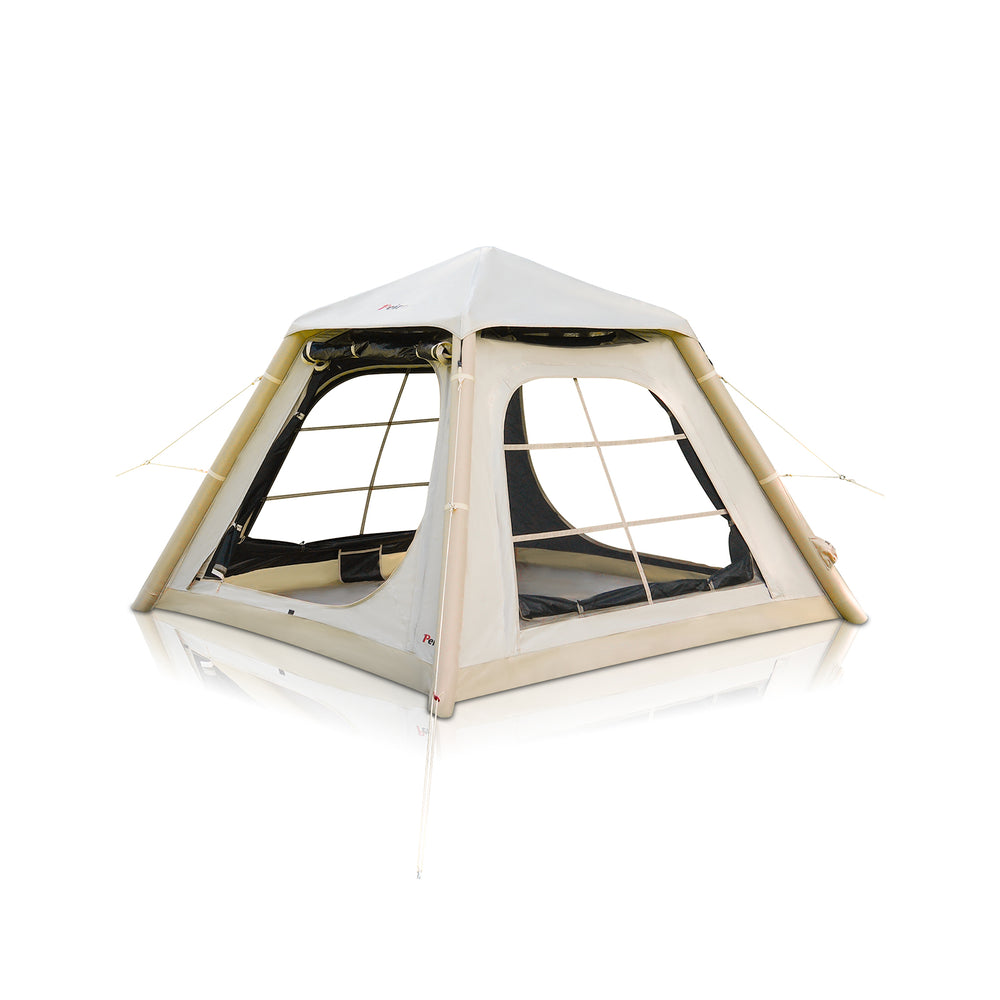
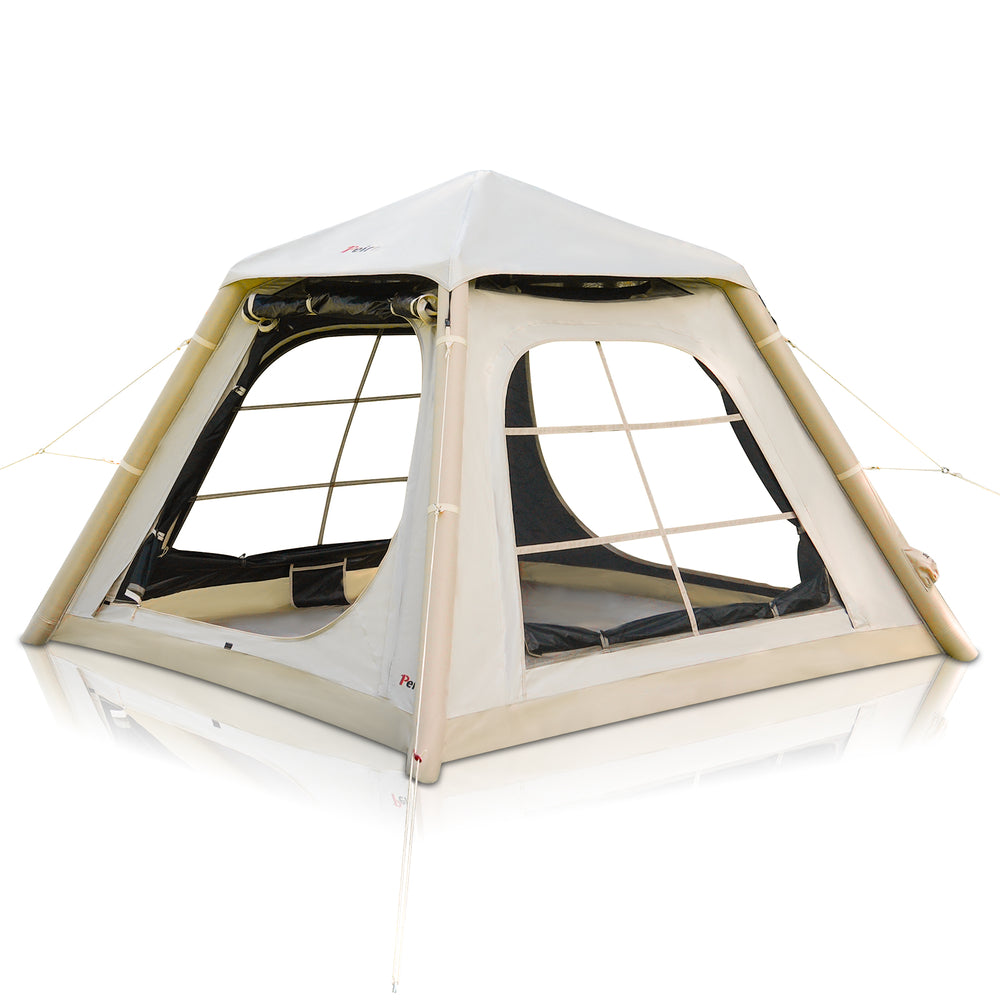
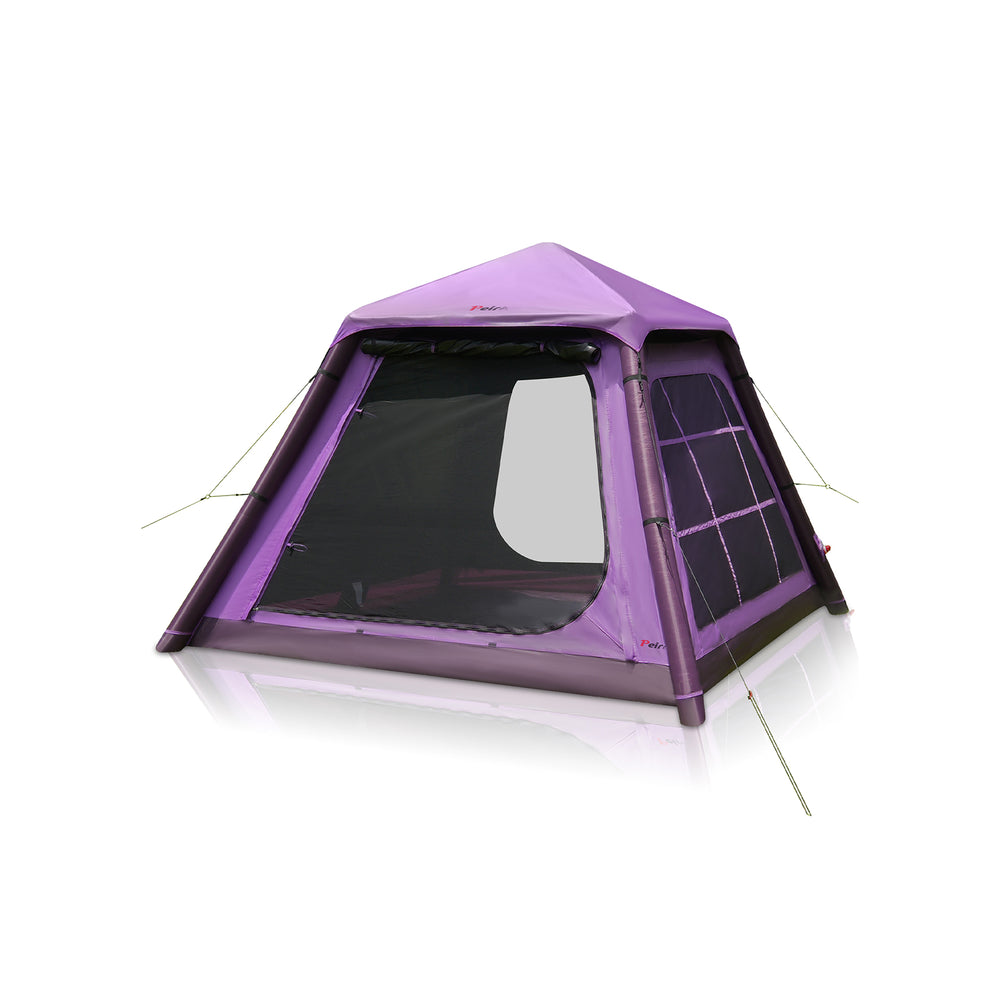
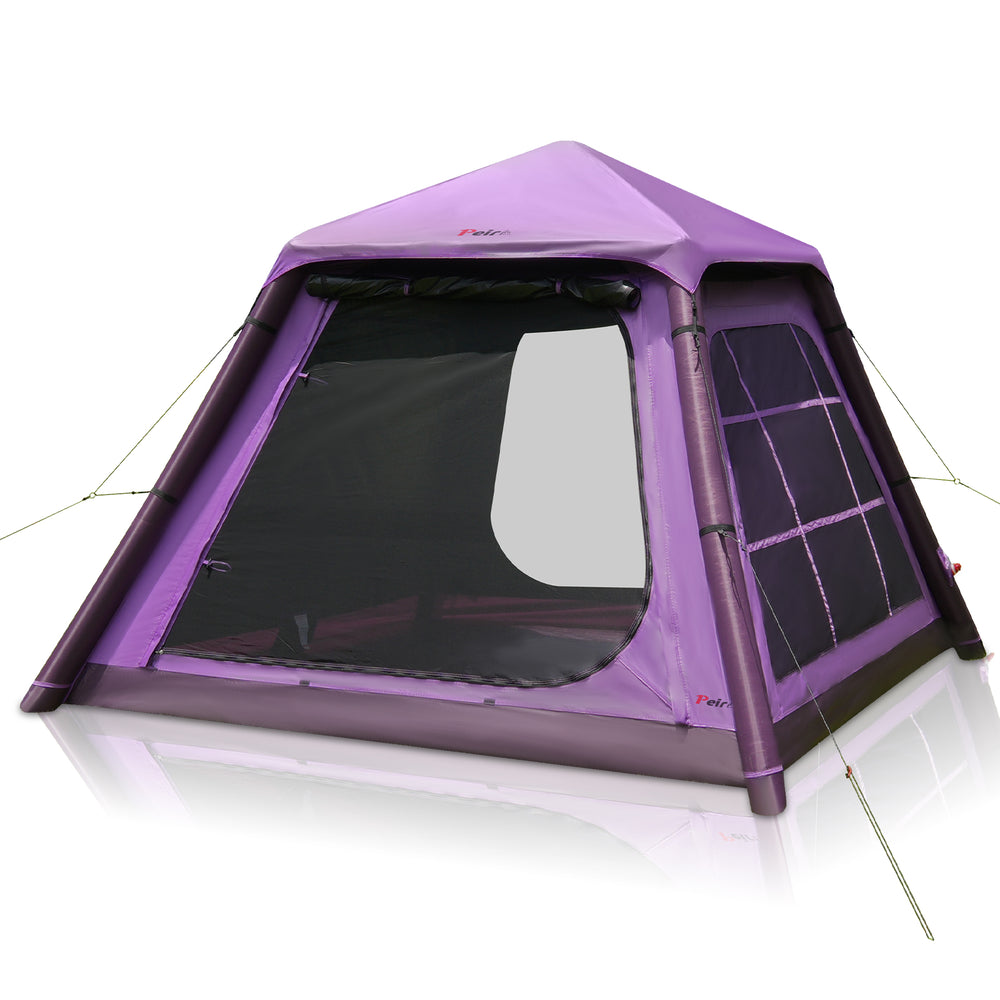
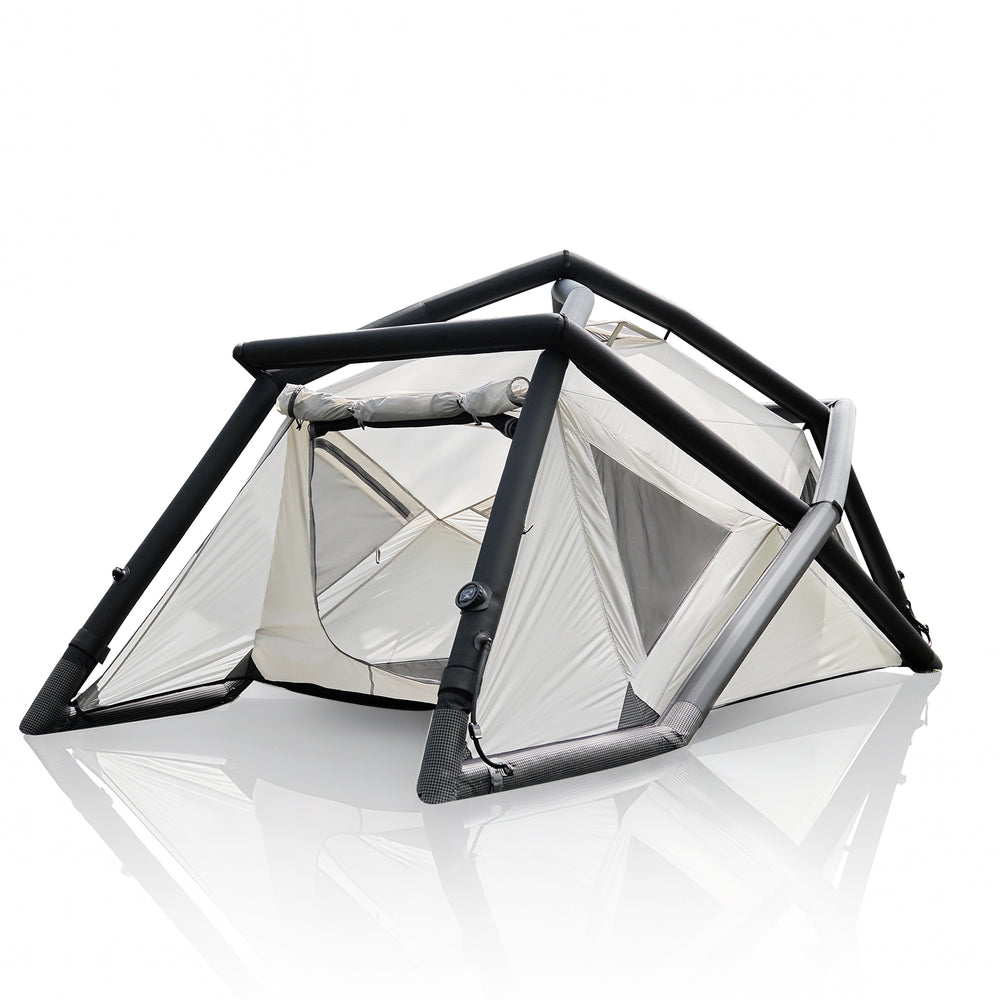
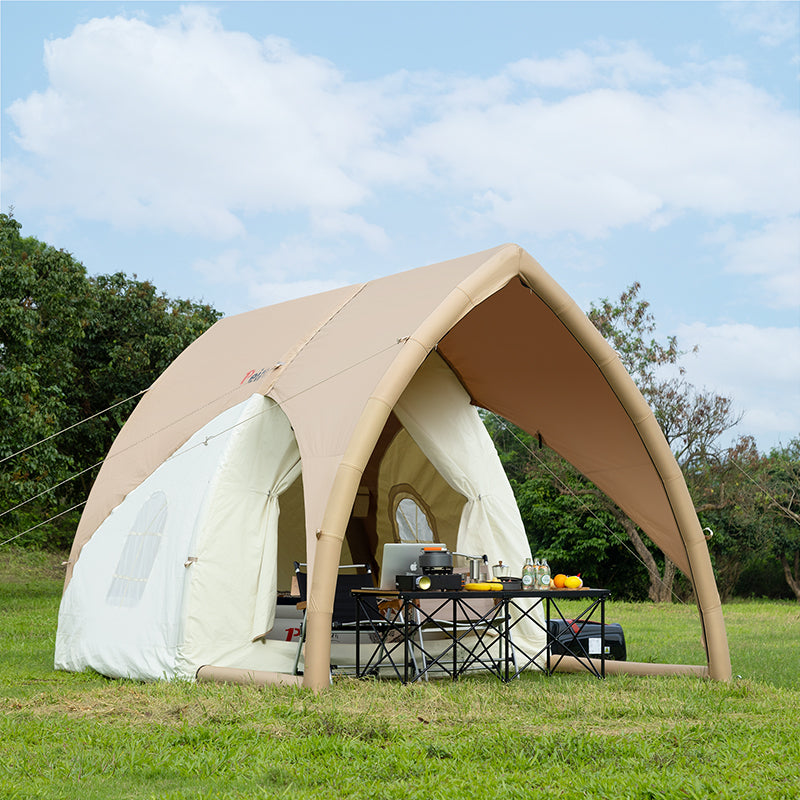 Peirhw Inflatable House Tent - Starry Night Love
Peirhw Inflatable House Tent - Starry Night Love
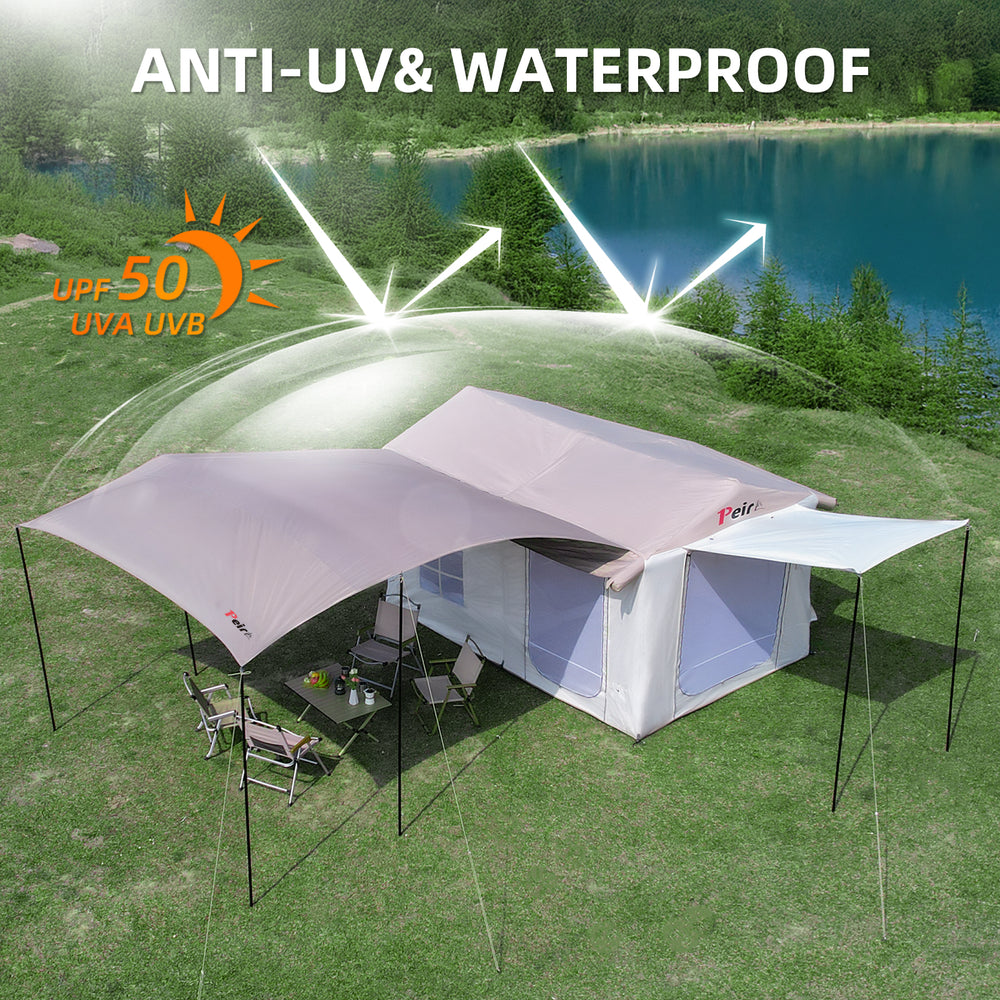 Peirhw Glamping Tents - Friendship Castle
Peirhw Glamping Tents - Friendship Castle
 Peirhw Inflatable Canopy Tent - Adventurer
Peirhw Inflatable Canopy Tent - Adventurer
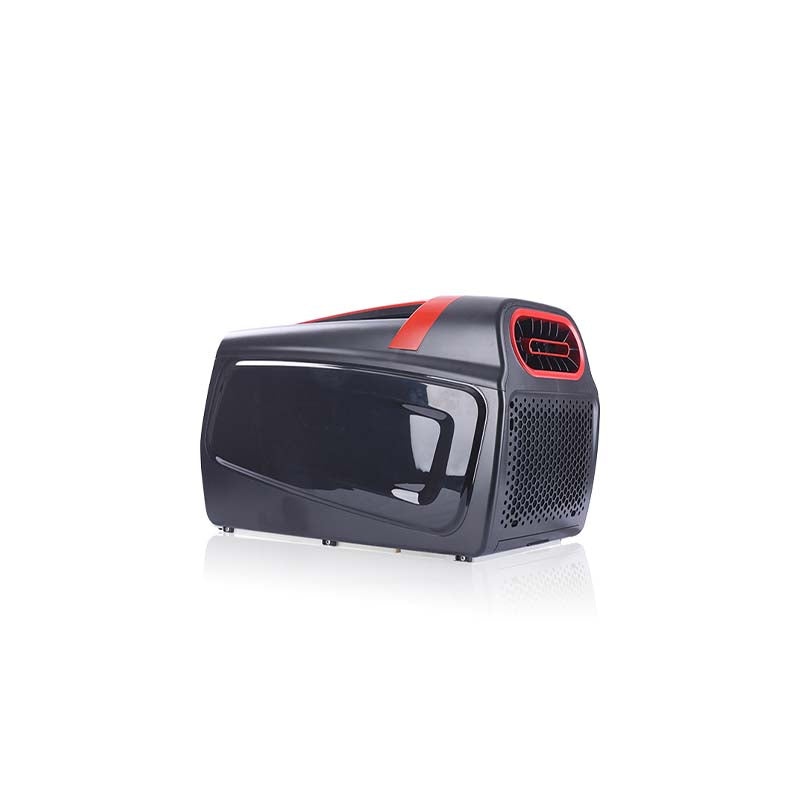
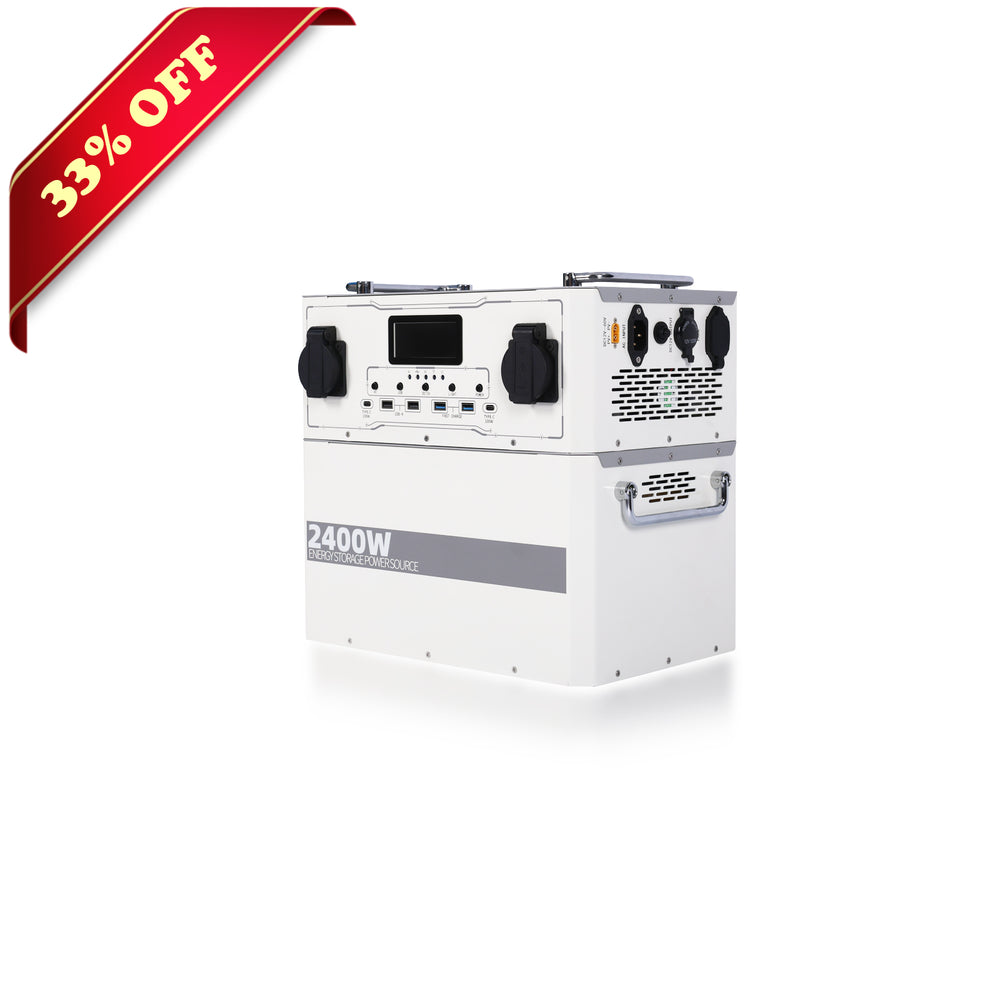
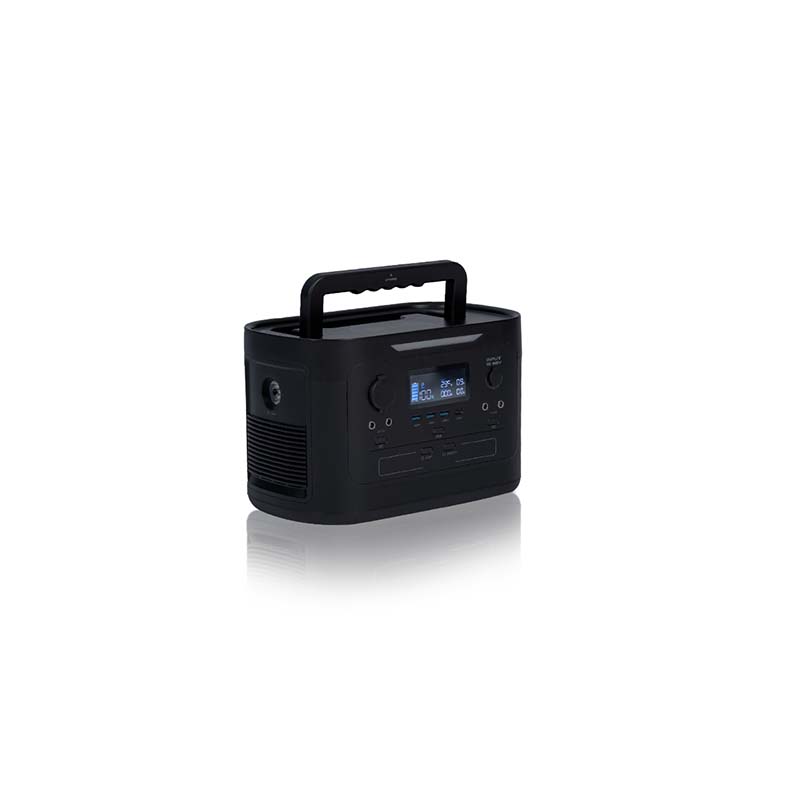
 Peirhw Portable Air Conditioner
Peirhw Portable Air Conditioner
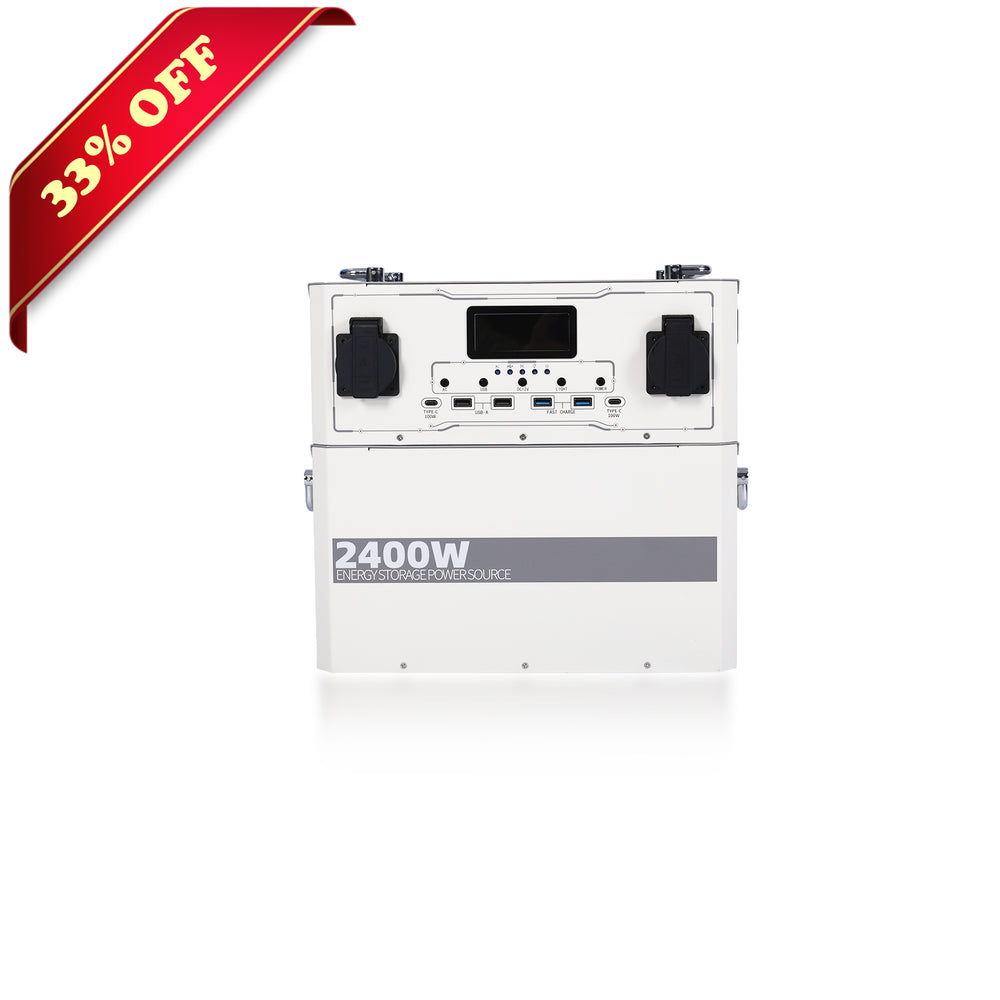 【Advance Sale】Peirhw Portable Power Station 2400W
【Advance Sale】Peirhw Portable Power Station 2400W
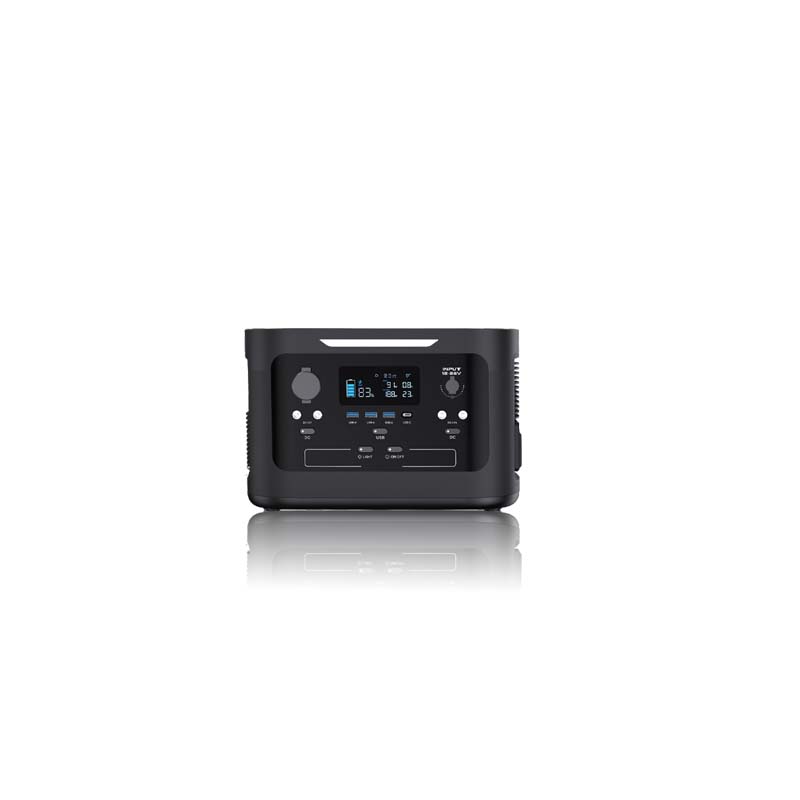 【Advance Sale】Peirhw Portable Power Station 600W
【Advance Sale】Peirhw Portable Power Station 600W
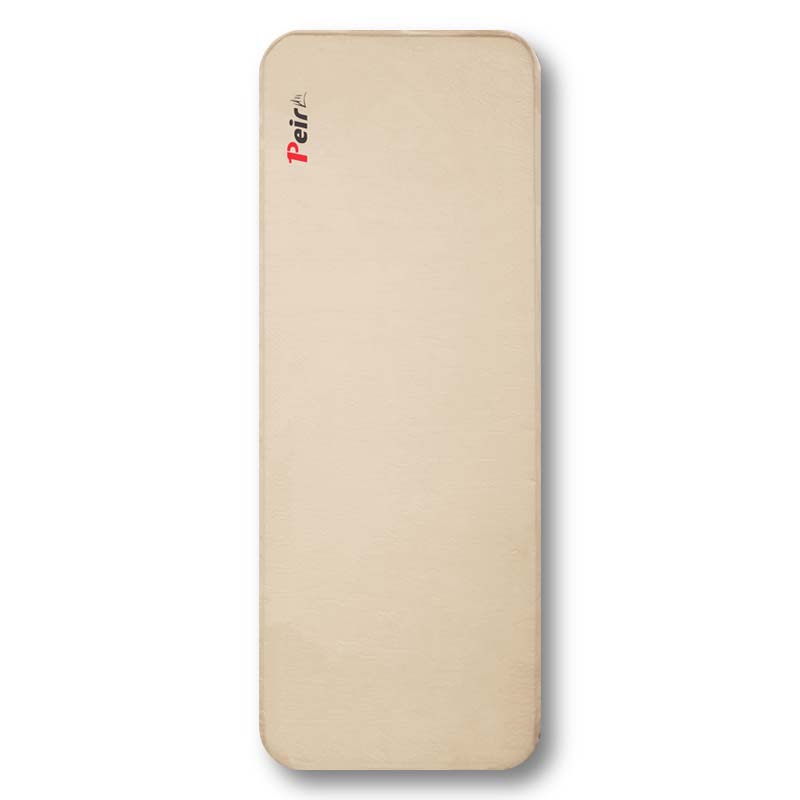


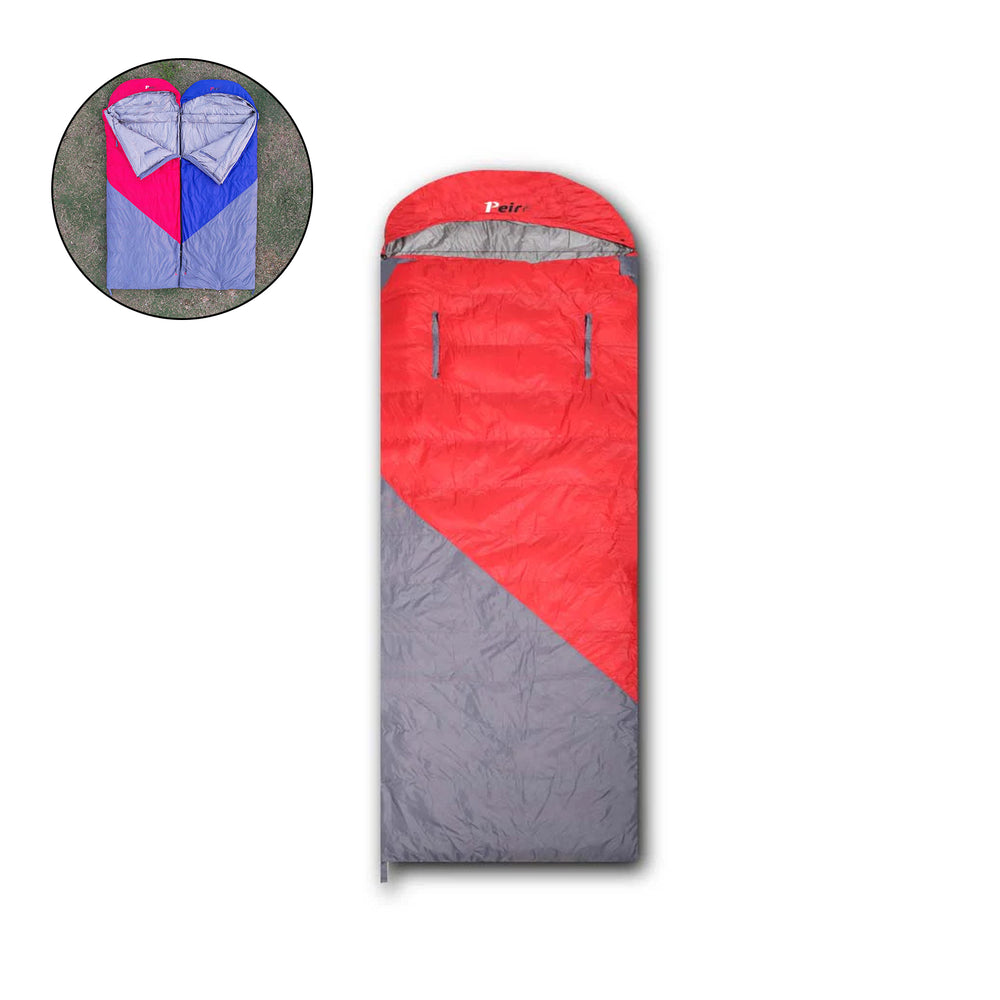
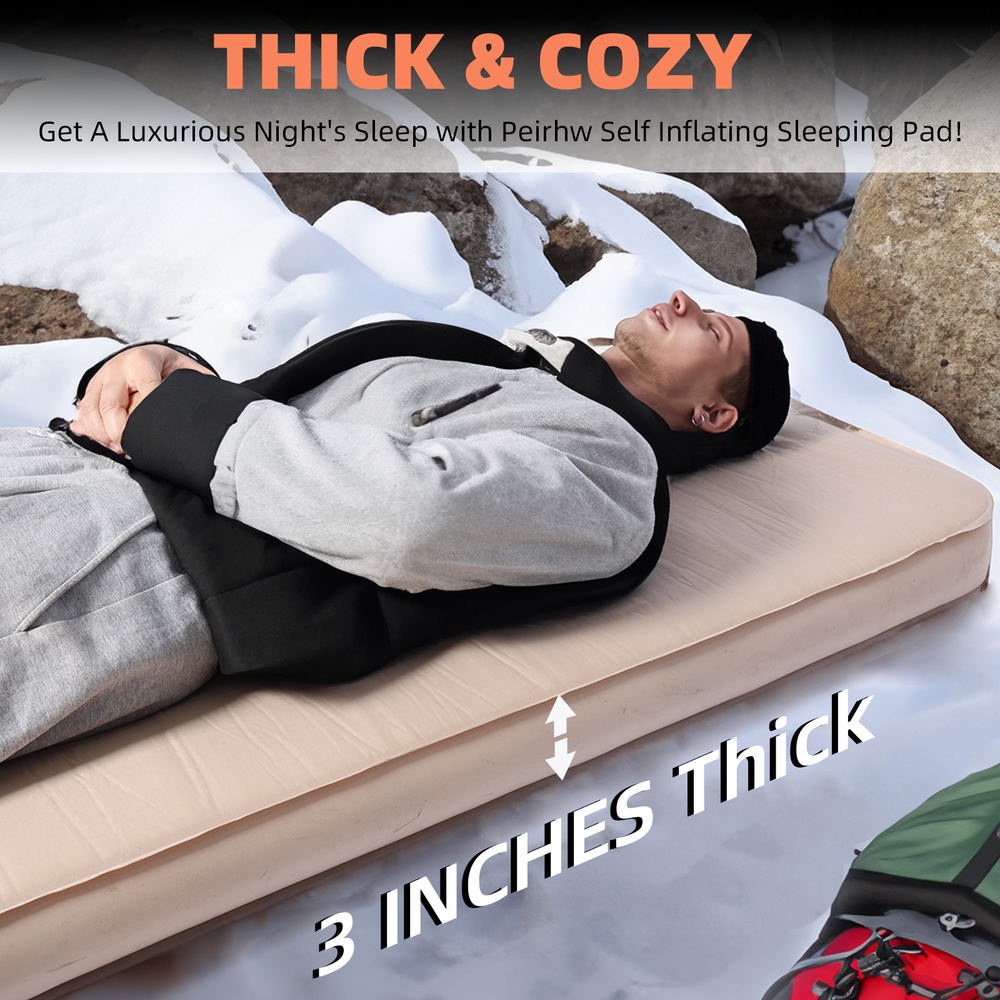 Peirhw Self Inflating Sleeping Pad
Peirhw Self Inflating Sleeping Pad
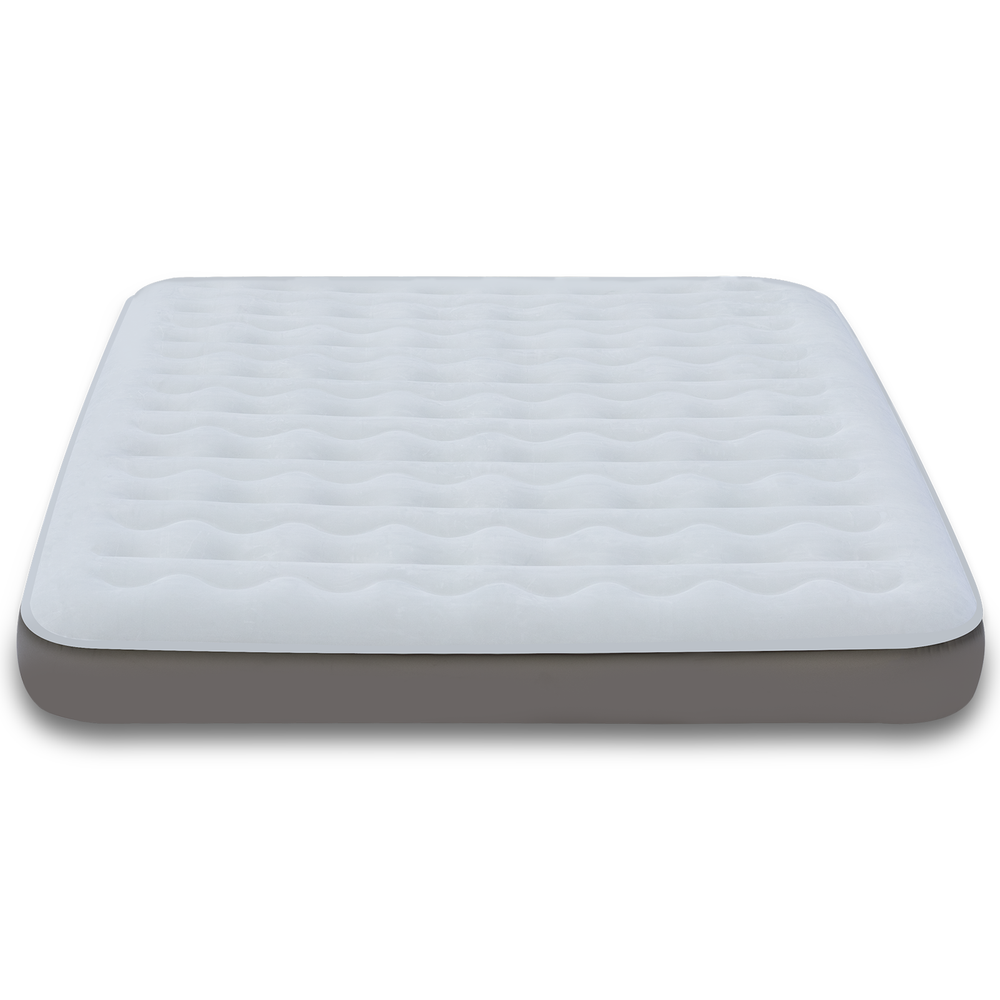 Peirhw Air Mattress (8" Queen Type)
Peirhw Air Mattress (8" Queen Type)
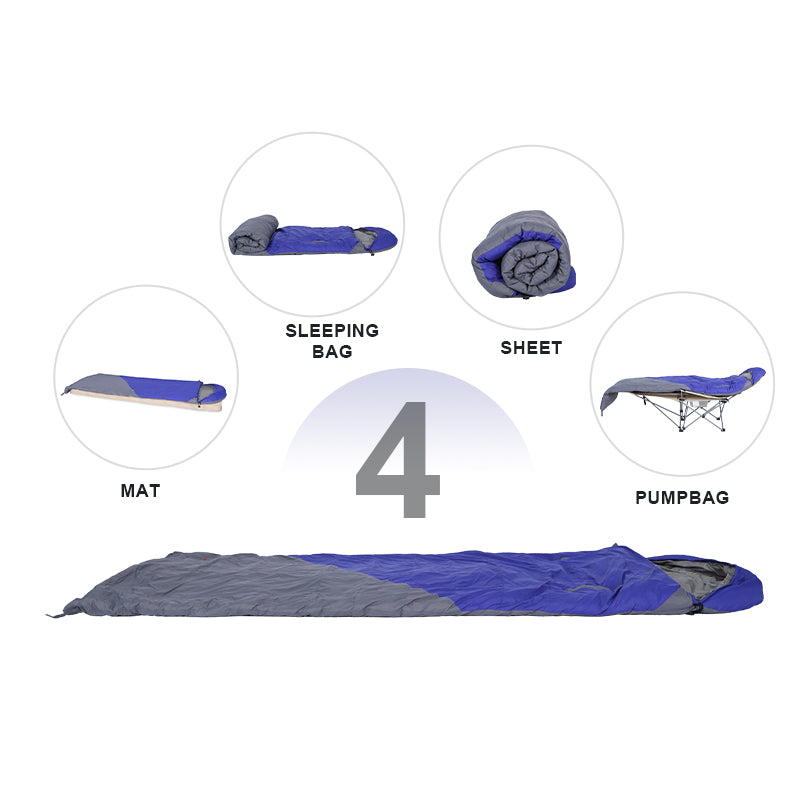 Peirhw Camping Sleeping Bag
Peirhw Camping Sleeping Bag
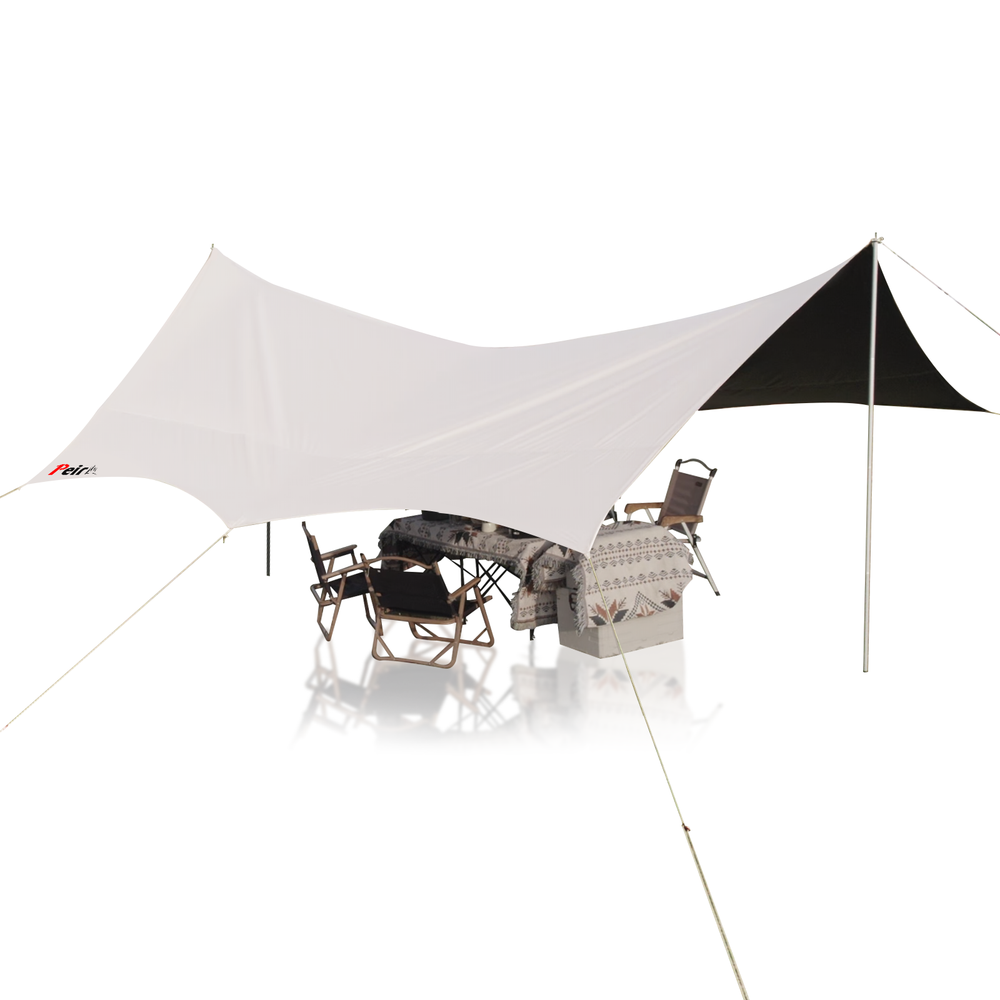

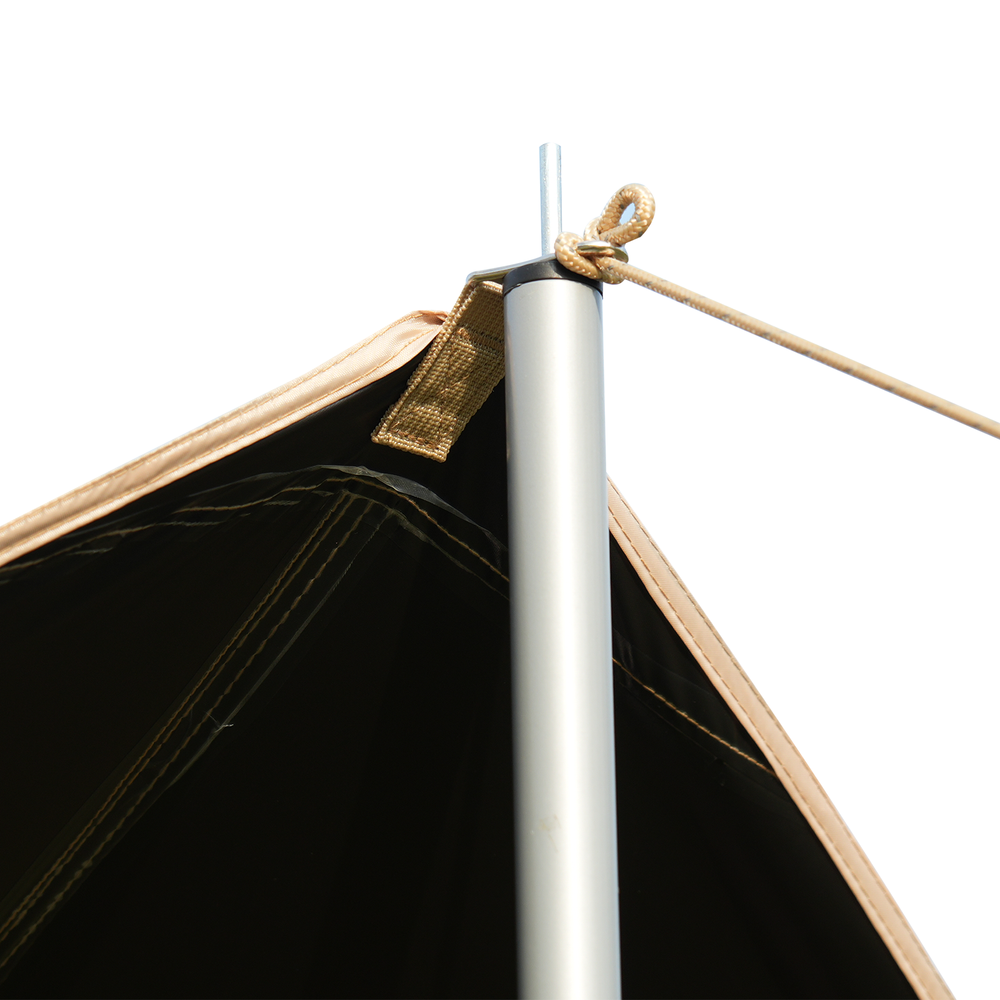 Peirhw Butterfly-shaped Canopy for Camping
Peirhw Butterfly-shaped Canopy for Camping
 Peirhw Camping Waterproof Canopy (Cannot be Purchased Separately)
Peirhw Camping Waterproof Canopy (Cannot be Purchased Separately)
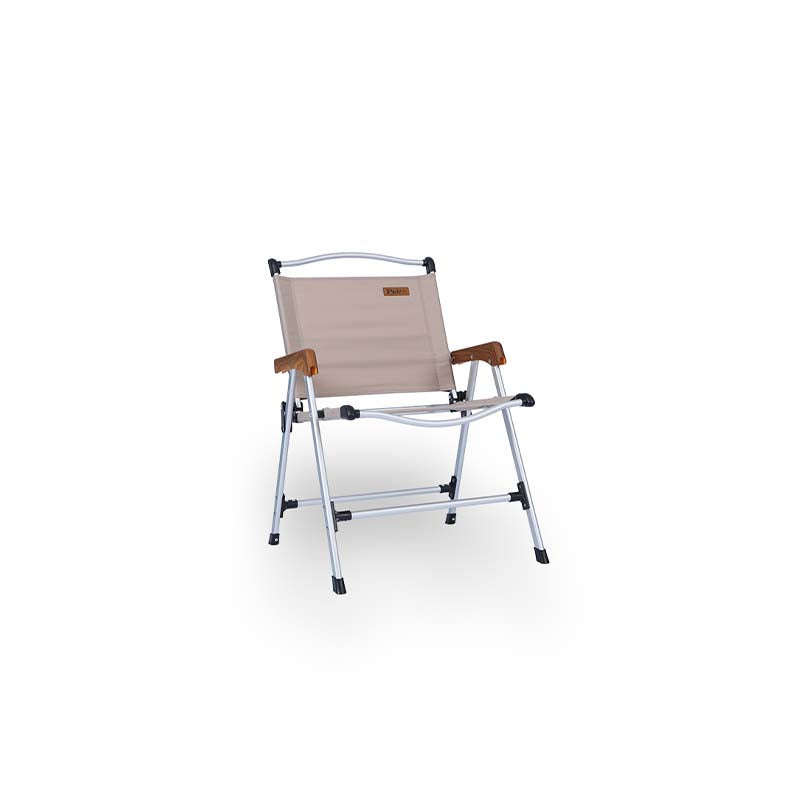
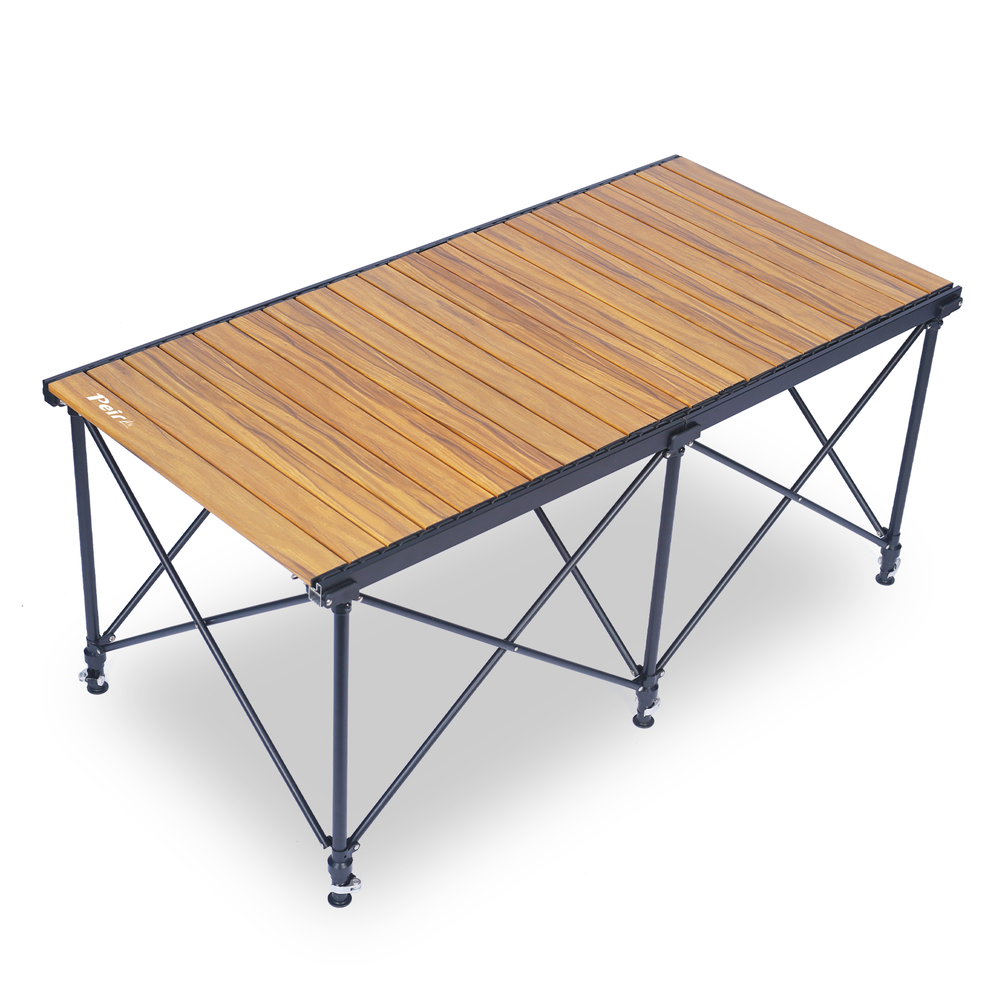
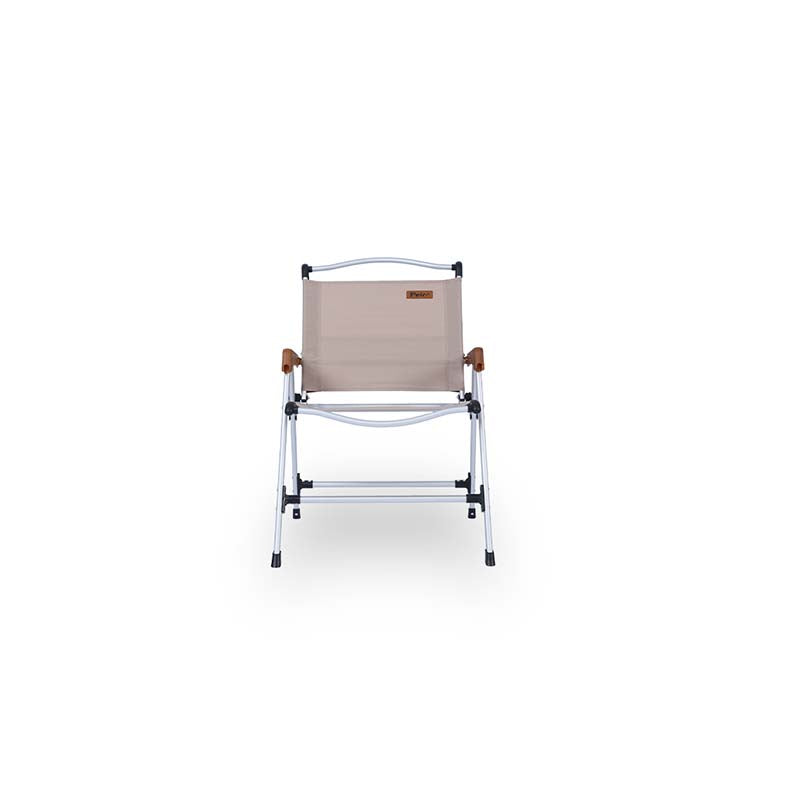 Peirhw Outdoor Folding Chairs
Peirhw Outdoor Folding Chairs
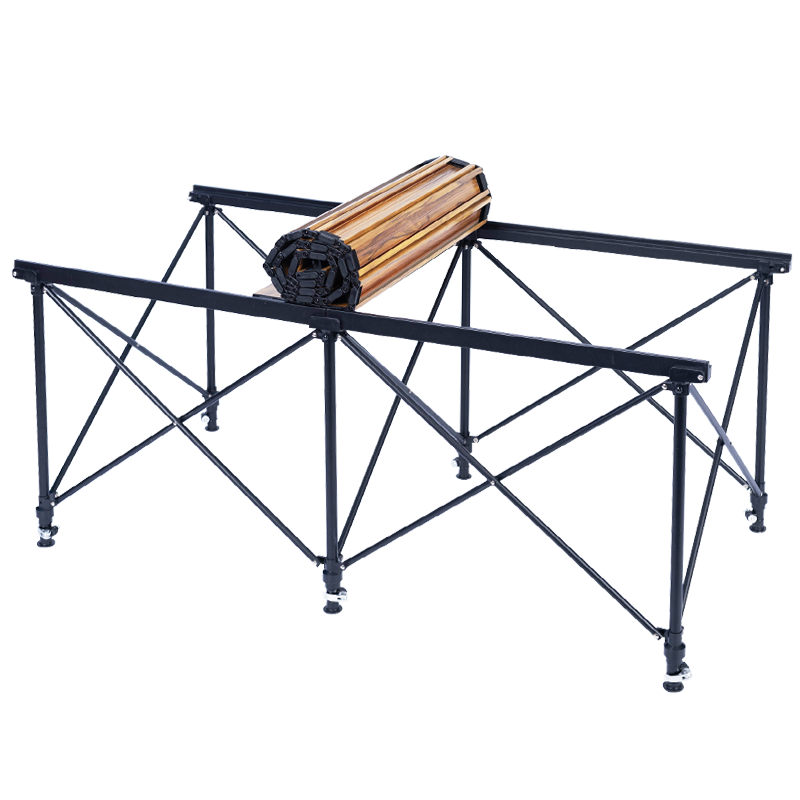 Peirhw Folding Camping Table
Peirhw Folding Camping Table





